On March 31st, 2023; my tour group arrived by flight to Da Nang, after spending several days in southern Vietnam. Now we were in central Vietnam. We boarded our next tour bus and proceeded on our way. Our guide purchased traditional Vietnamese Bahn Mi sandwiches(crusty bread roll filled with veggies) for us to enjoy during our lengthy drive.
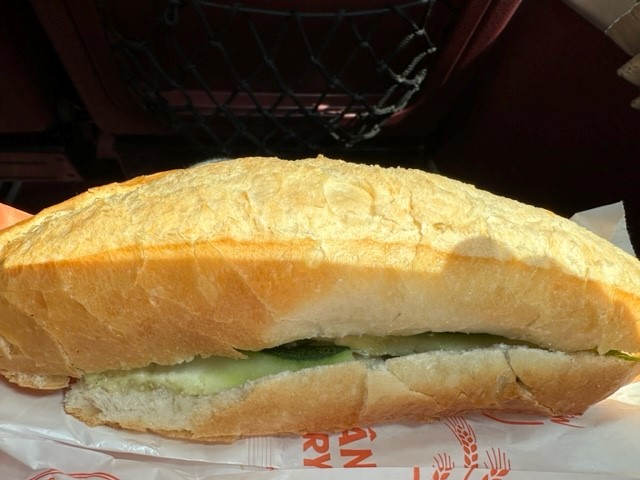
Eventually we made our way to our next destination…the ancient town of Hoi An.
This coastal city is known for its historic Old Town and glorious canals. The city’s architecture showcases a variety of designs and cultures from Chinese temples to French colonial buildings to Vietnamese narrow “tube houses”, and a Japanese Covered Bridge with a pagoda.
Upon entering the Ancient Town center, one sees an iconic 17th century Japanese, commercial sailboat on display.
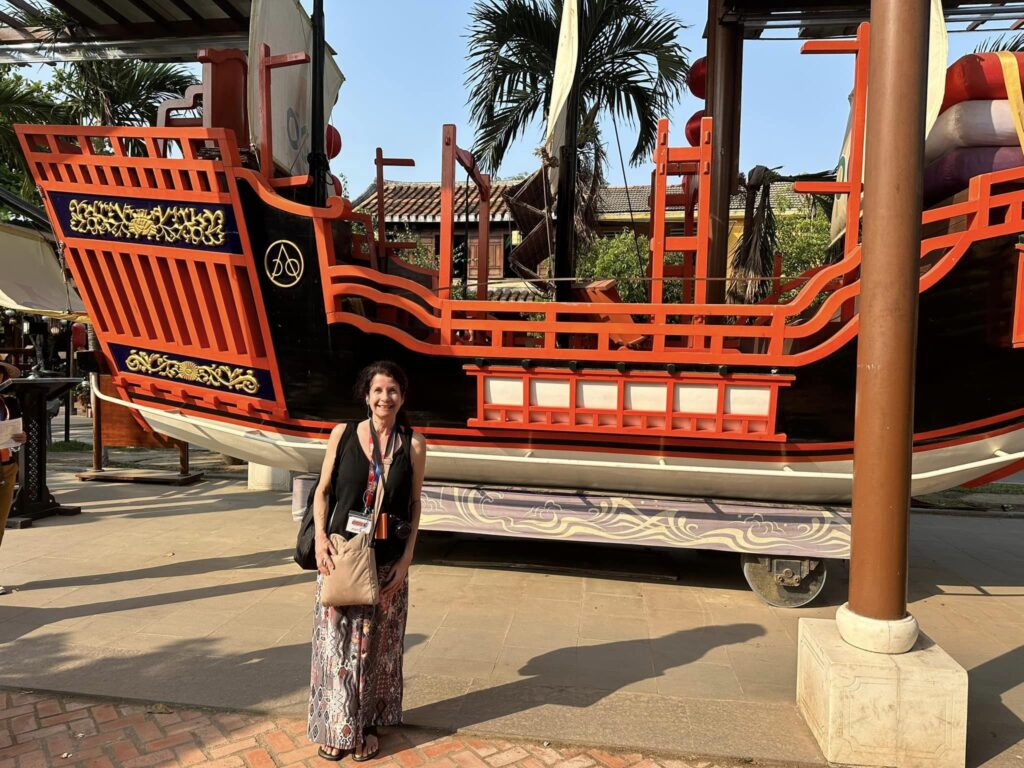
We strolled by several temples with ornate and colorful gates in Old Town.
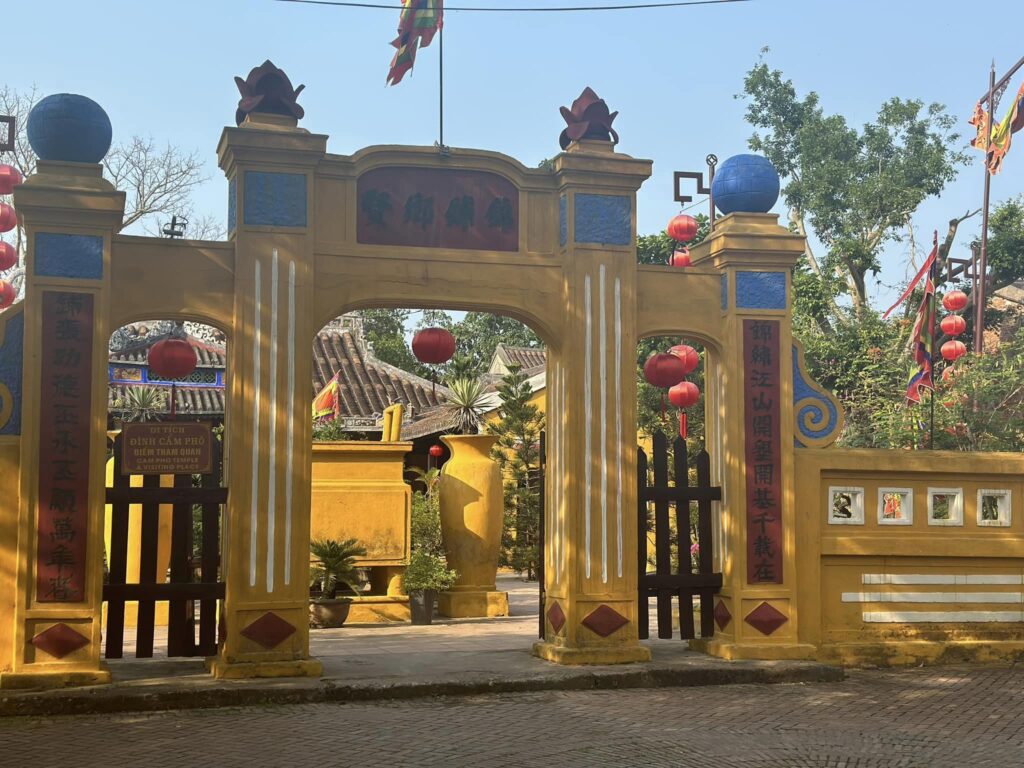
A plethora of gift shops sold everything from clothing to jewelry to figurines. Several shops sold colorful and decorative fabric lanterns, which is what the town is known for. I purchased this must-have traditional Vietnamese souvenir!!
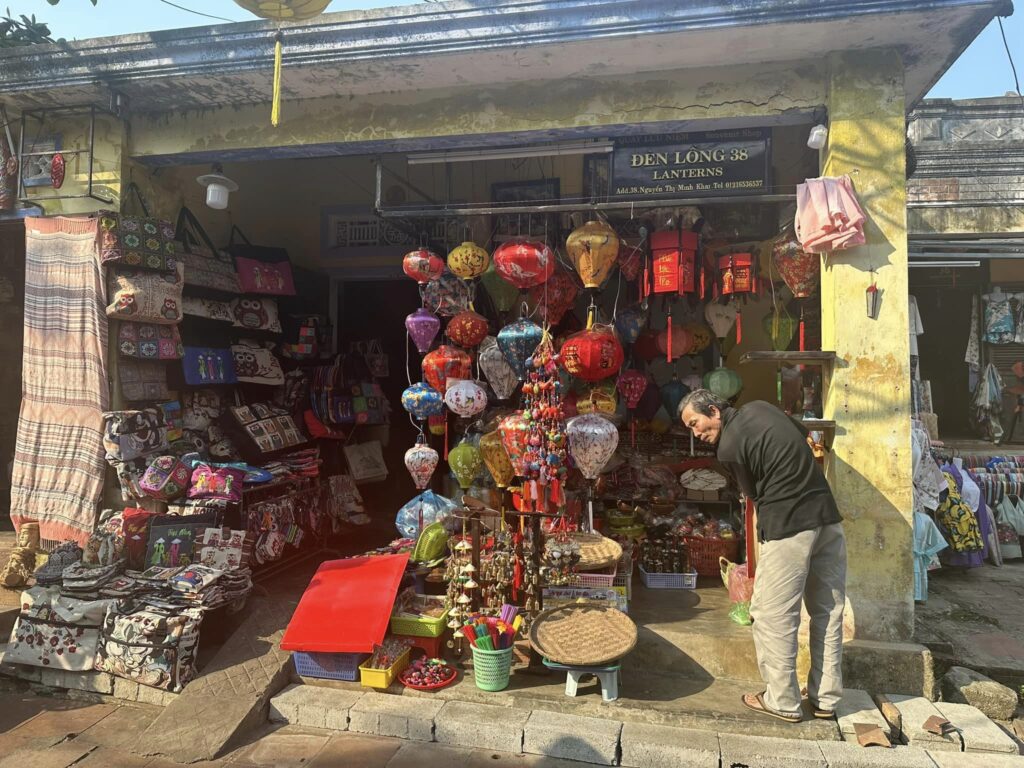
Art galleries also came across our path, including this one located in a colorful and fancy building.
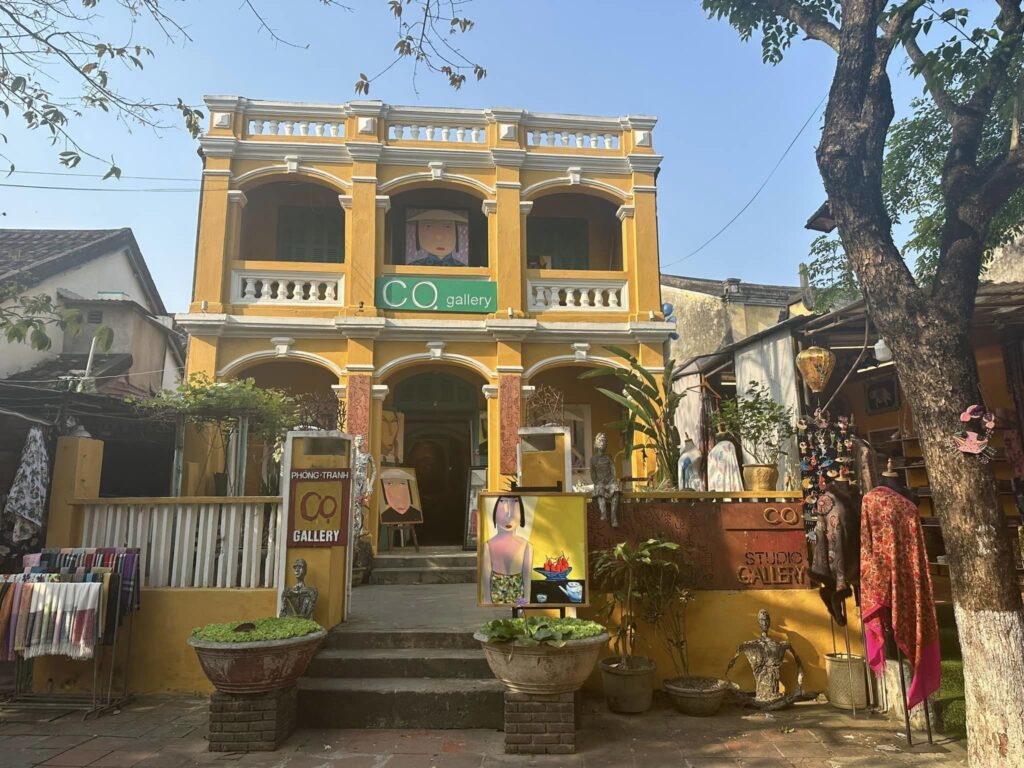
We then arrived at the first destination of our sightseeing agenda.. the Phung Hung Ancient House. Shortly after exiting the Japanese Covered Bridge, the house appears on the left side of the street. This 200 year old home is known to be one of the oldest ones in the city. The structure and its interior is comprised of Vietnamese, Japanese and Chinese architectural styles. Many of its furnishings are 19th century original belongings. Within the residence is a gift shop that sells Vietnamese handicrafts.
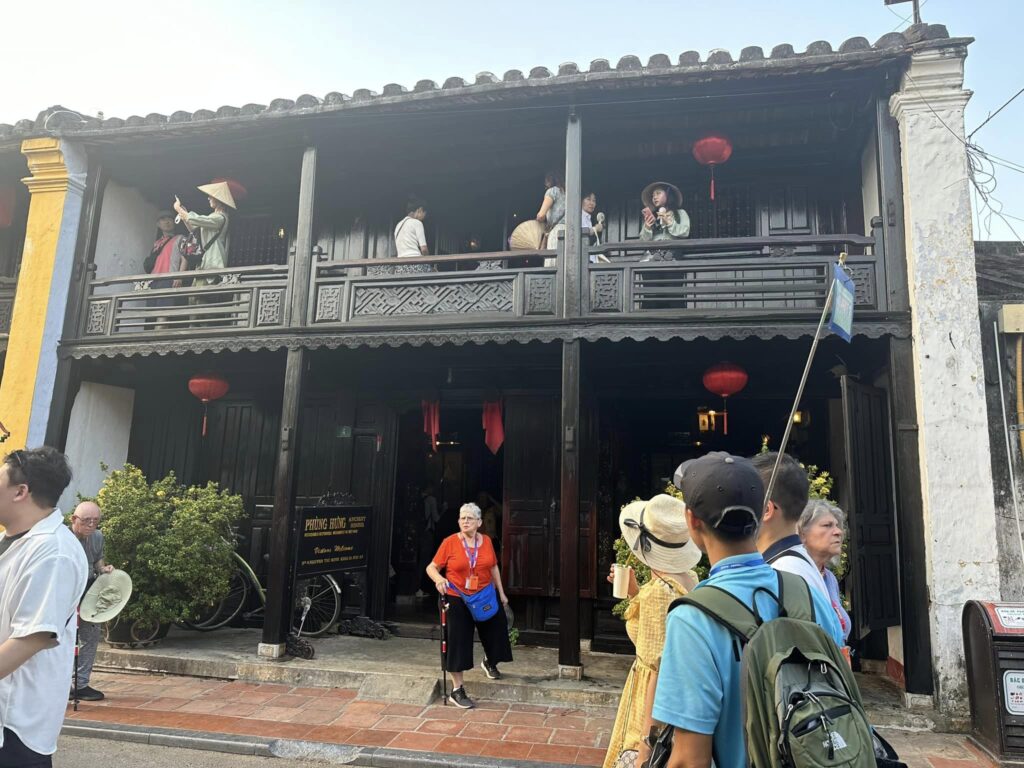
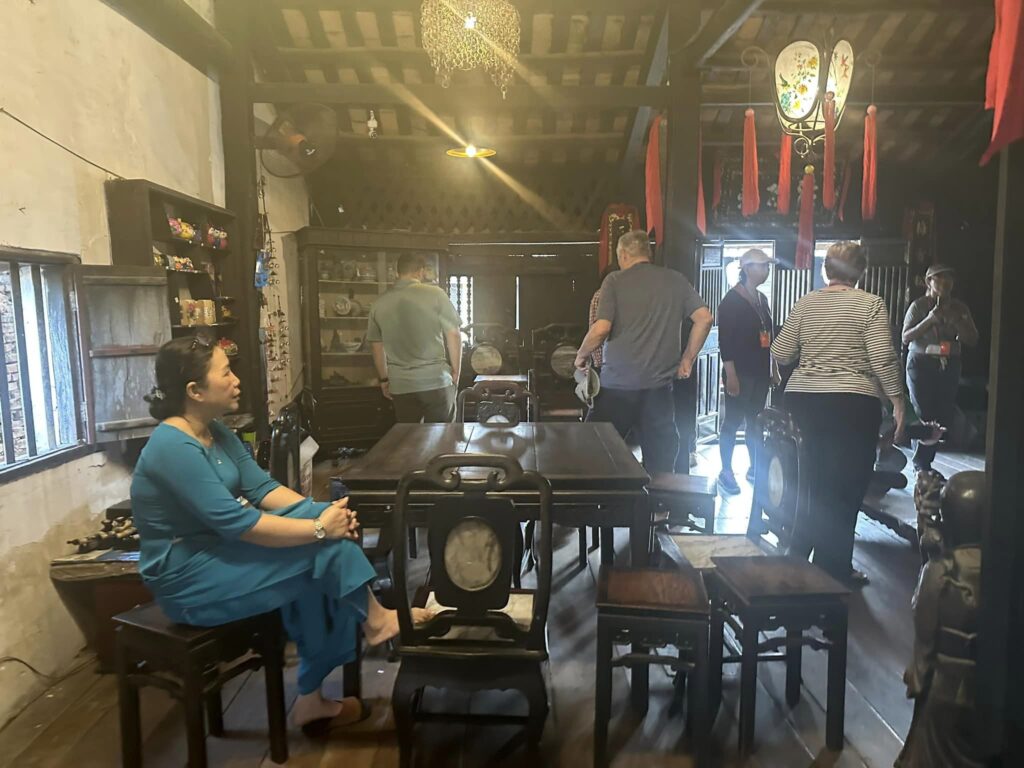
As we proceeded our walk down the Old Town main street, we noticed the charming yellow houses, shops, and restaurants. In local culture, the color symbolizes royalty, luck, pride and prosperity. Also, yellow absorbs less heat and is appropriate for the humid weather in Vietnam. The Chinese-tiled roofs and colorful lanterns hanging from the building exteriors made for a truly local experience.
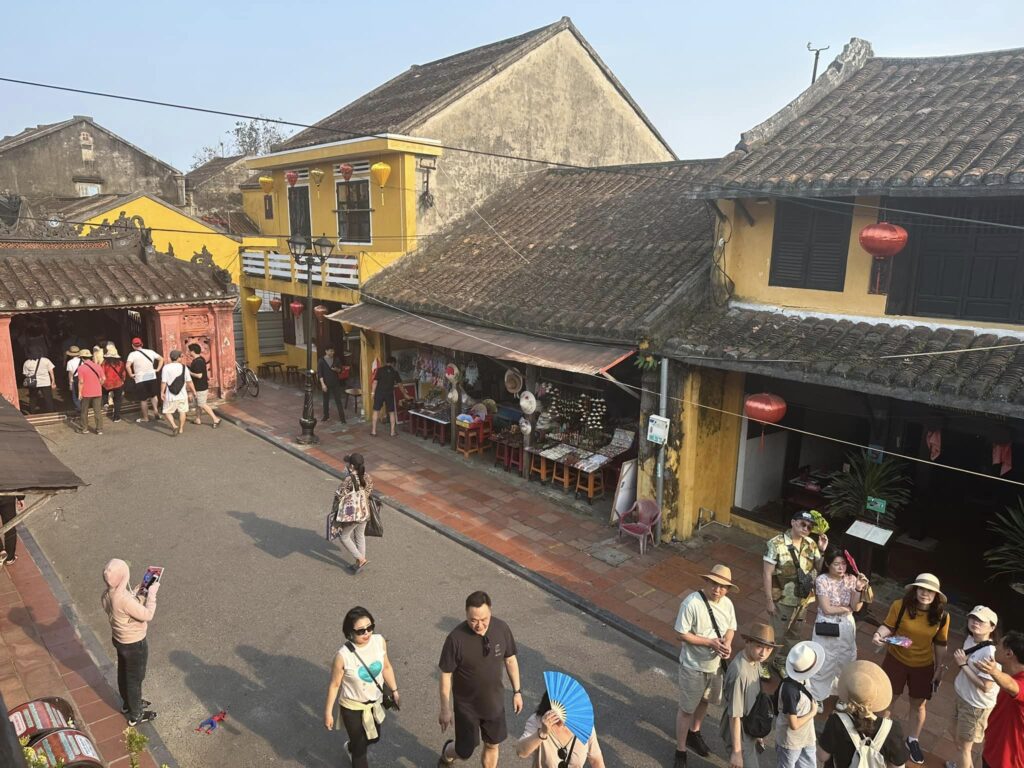
A little further down the road is the oldest house in Hoi An. The 15th century residence “Tan Ky” was originally a home for seven generations of family, as well as a trading post for local merchants and international traders.
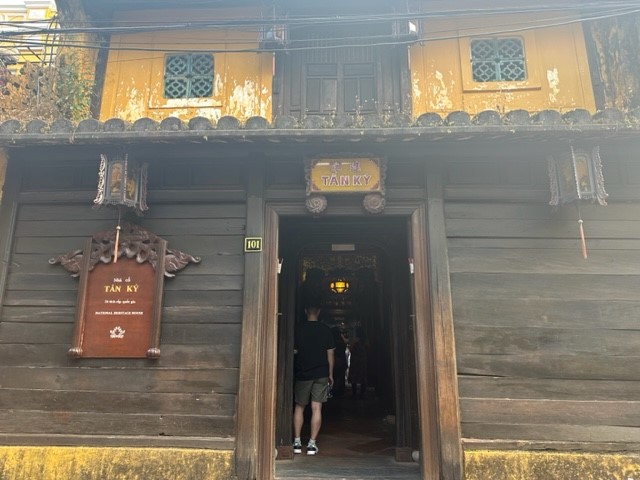
Chinese temples reside within Old Town and are popular with tourists for their intricate architecture and enteance gates.
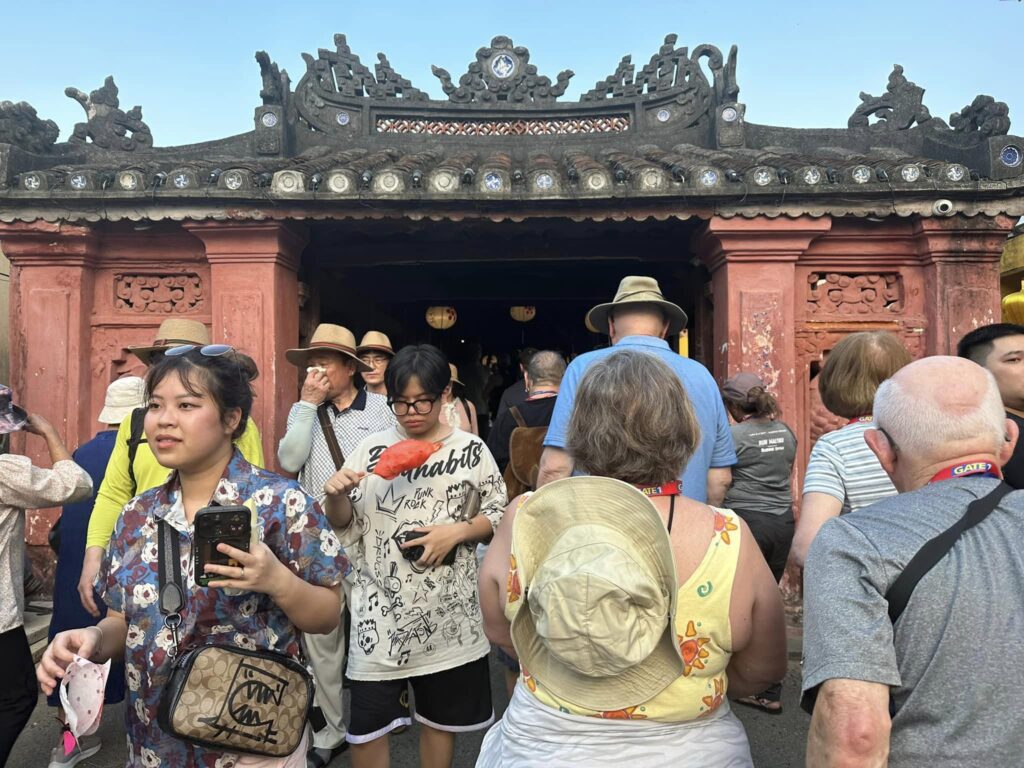
We visited a couple of Buddhist temples and pagodas along Old Town’s streets. This included a stop at the 18th century Assembly Hall of the Cantonese Chinese Congregation, erected by businessmen from China. The assembly hall was originally built to worship the Mazu goddess and Confucius. Hoi An was a major Vietnamese trading port during this era. This assembly hall was also where Cantonese community gathered to help each other in business and daily life. Its one of the most popular tourist attractions in this ancient town.
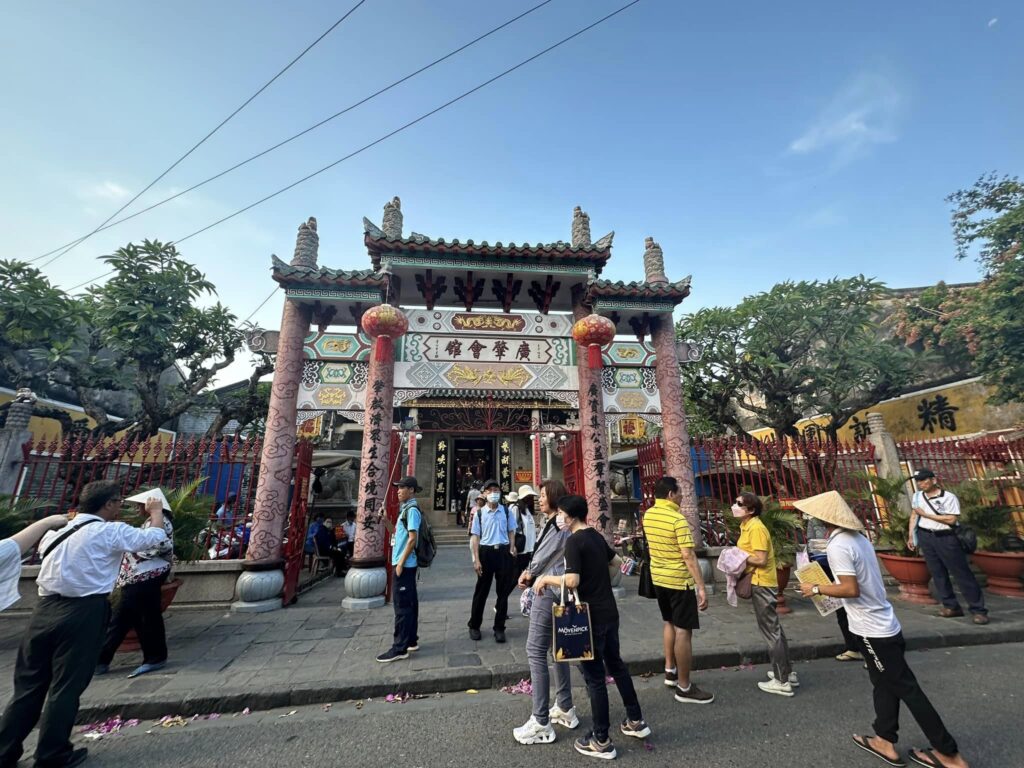
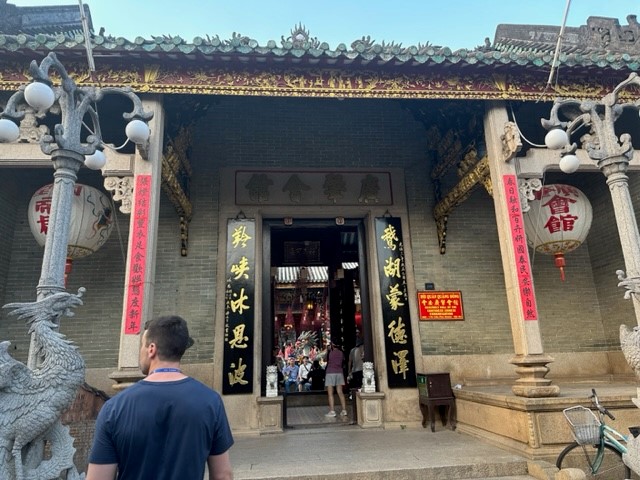
Once inside the courtyard, visitors are greeted by elaborate dragon statues.
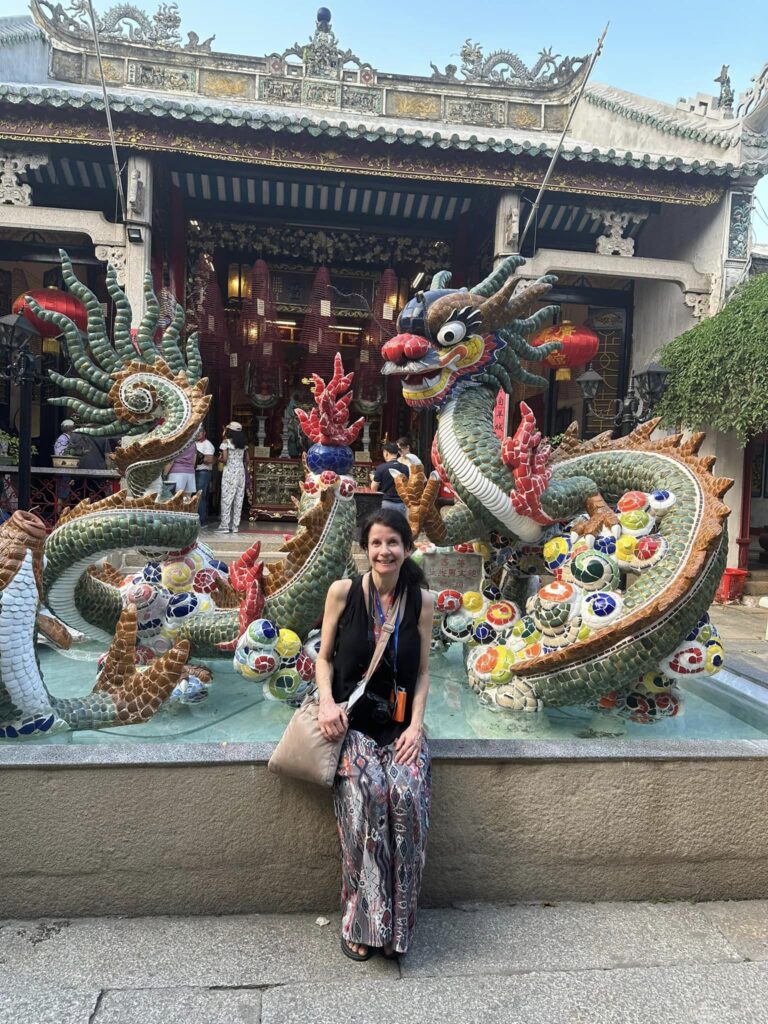
Flowers, fruits, and other offerings are placed on the Buddhist altars.
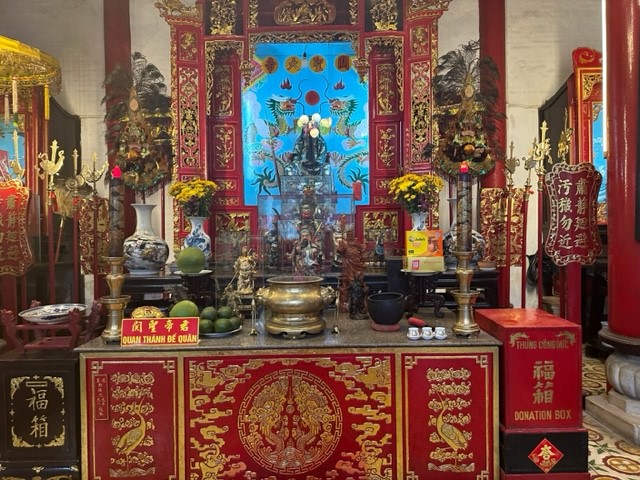
As we strolled further along Old Town’s main road, we noticed many people on rickshaws, locals and tourists alike wearing Vietnamese conical hats, and gift shops galore!!
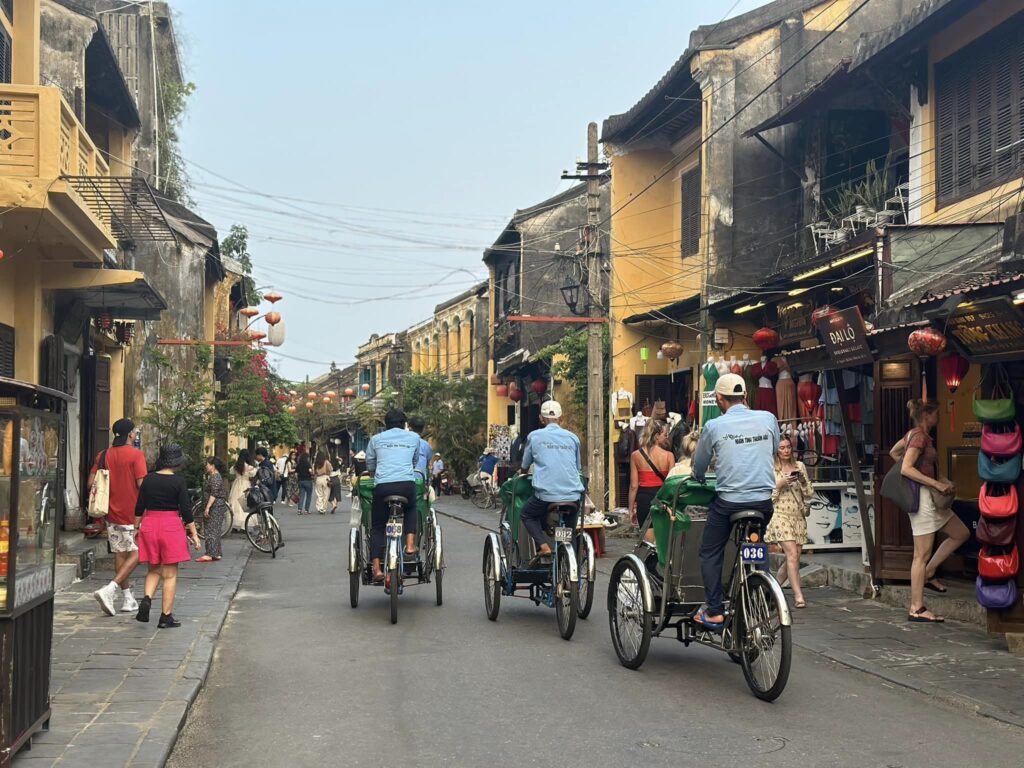
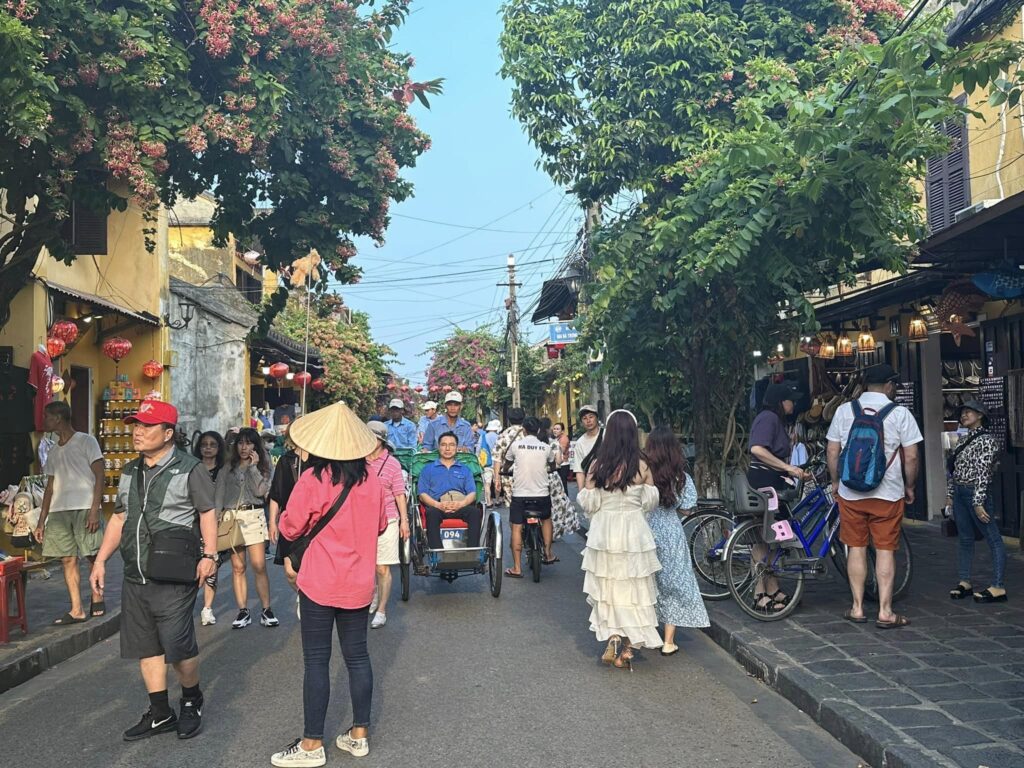
Dinnertime had arrived and I joined my tour group at a lovely restaurant in the lovely center of Old Town. I dined on a delicious meal of pumpkin soup, fried veggie wontons, greens, tofu with peppers, and a dessert of pineapple and banana. My beverage was a refreshing cashew smoothie.
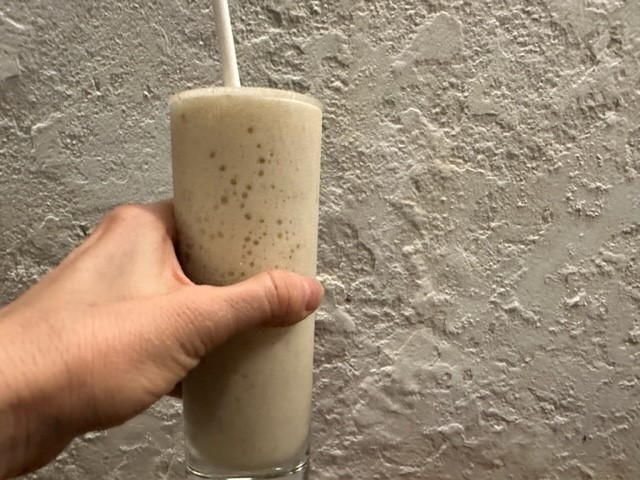
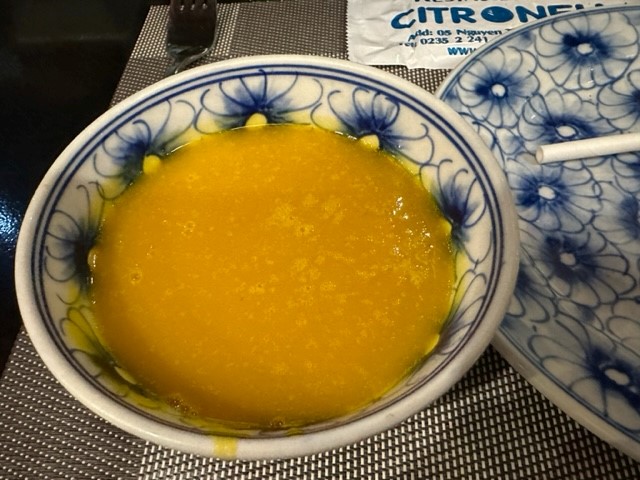
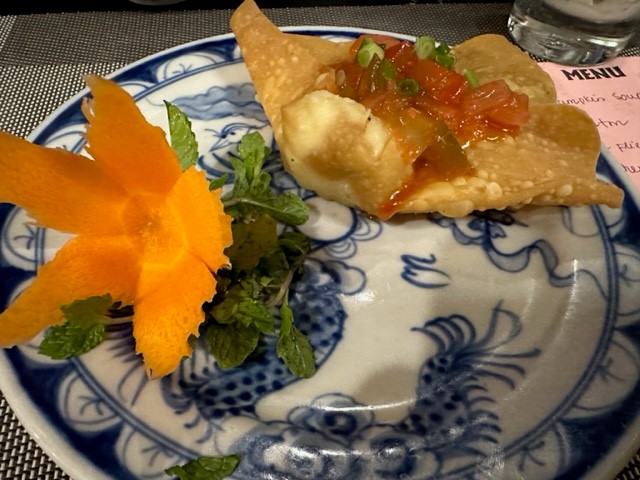
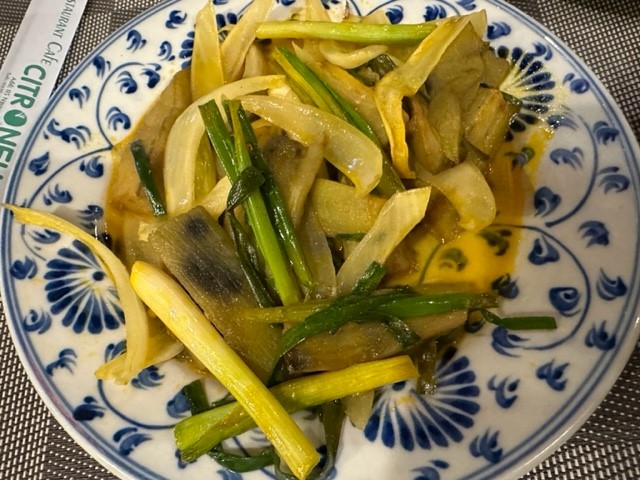
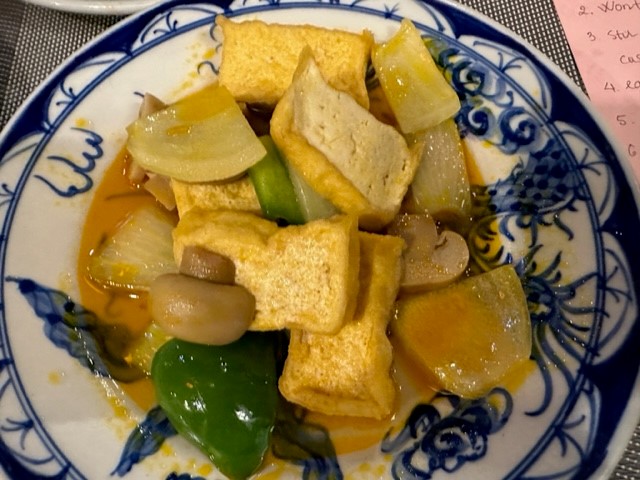
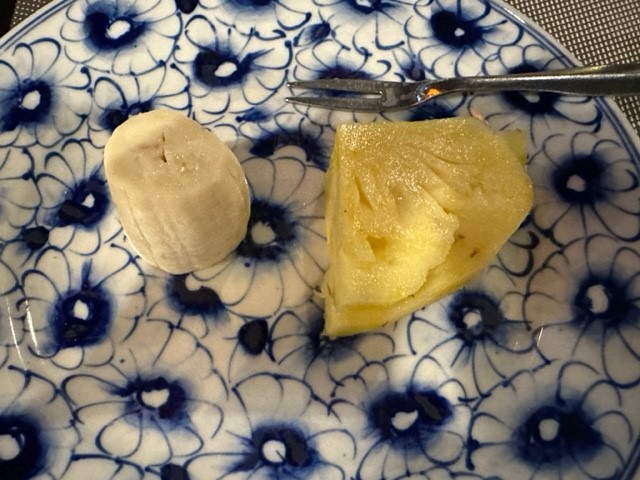
Our group was given free time in the evening to stroll around town or go shopping. I enjoyed my time walking around Hoi An at night.
Street vendors were selling fruit hoisted in bamboo baskets hung by a pole.
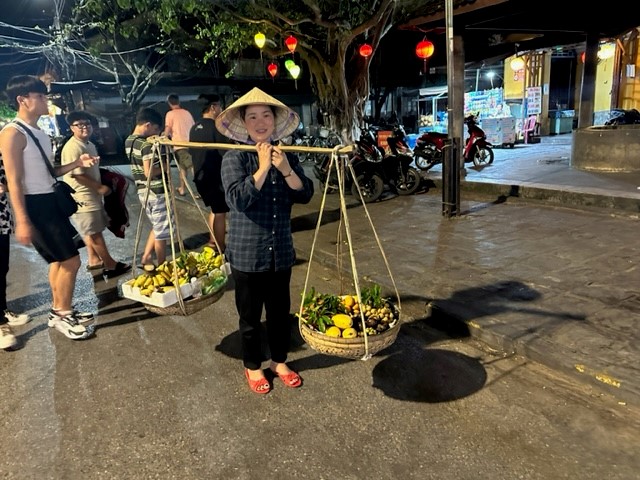
The small coconut boats cruised upon the canal, with their lit up lanterns. For a small fee, tourists could take a ride for an hour or so. The town’s buildings looked stunning, lighted in bright colors.
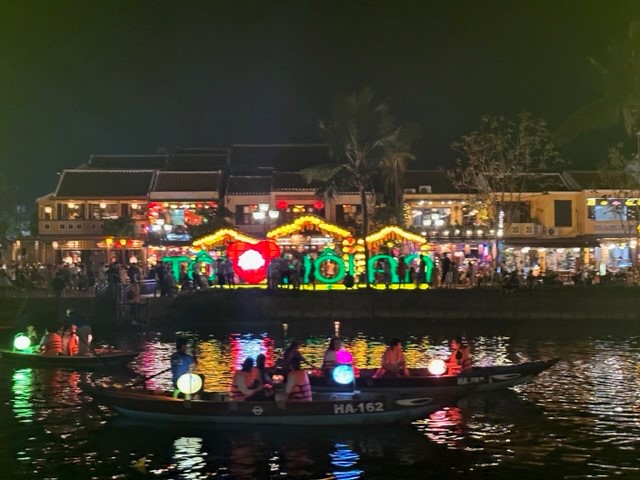
I noticed the covered bridges in Old Town, along my walk. The 17th century Japanese Bridge was built by businessmen. It is linked with a legend of a monster called Namazu. This mythical creature legend states that its movements cause earthquakes and floods.
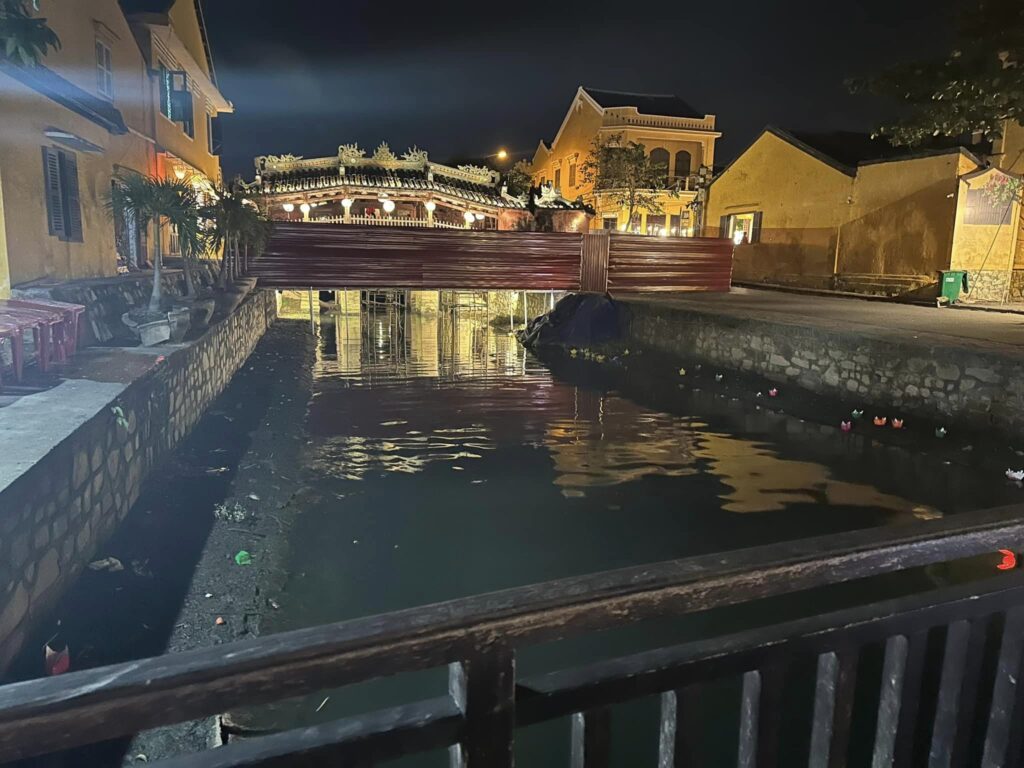
The lanterns hung between the shops and buildings of Old Town, look especially picturesque when lit up at night.
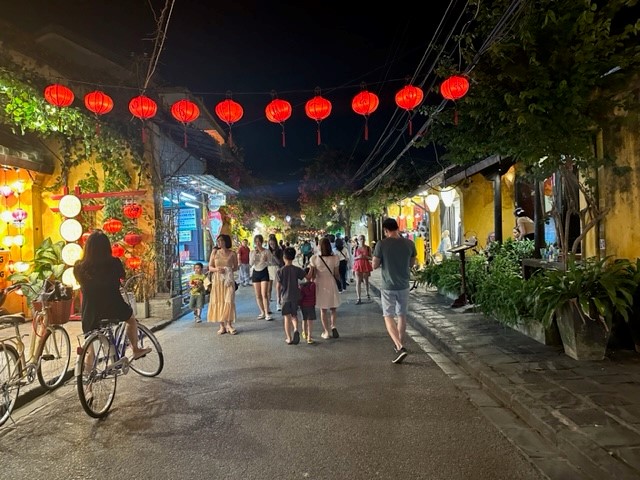
It was time to call it a night and get some sleep. The next morning, I headed down to the hotel’s restaurant for some breakfast. My morning meal was a plate of fresh local fruit including mango, dragonfruit, pineapple, and watermelon. The local Asian fruits are so flavorful!! I also enjoyed a filling plate of beans, tomatoes, broccoli, carrots, peppers, bok choy, and glass noodles.
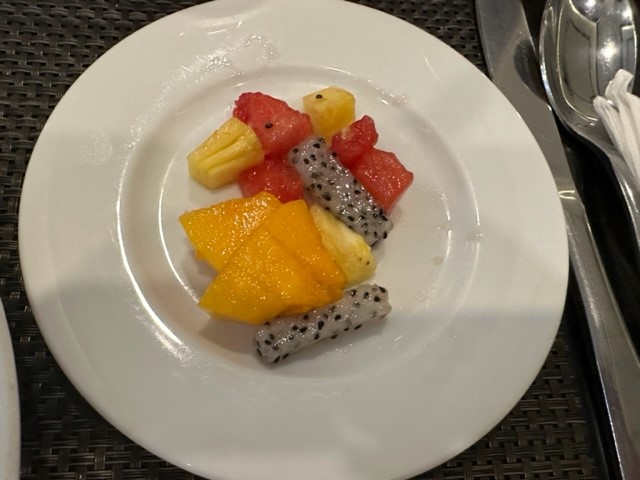
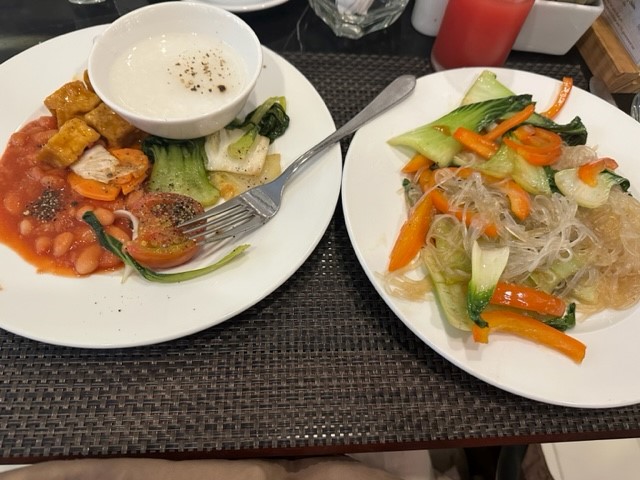
My tour group then headed to a dock to take a small boat to Kong Island on Thu Bon River.
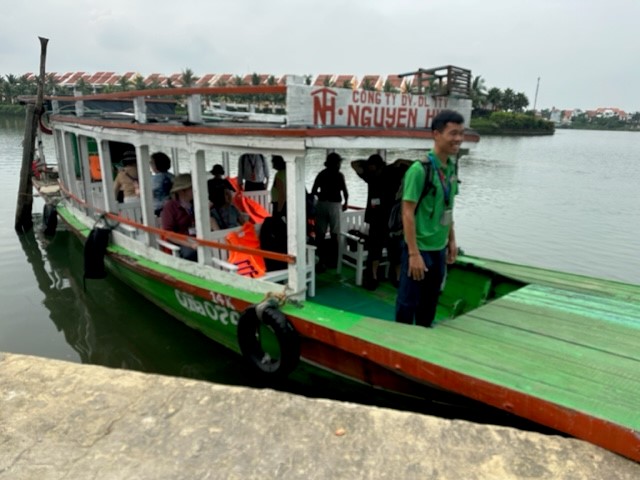
Residences surrounded by towering palm trees met our gaze along the waterway.
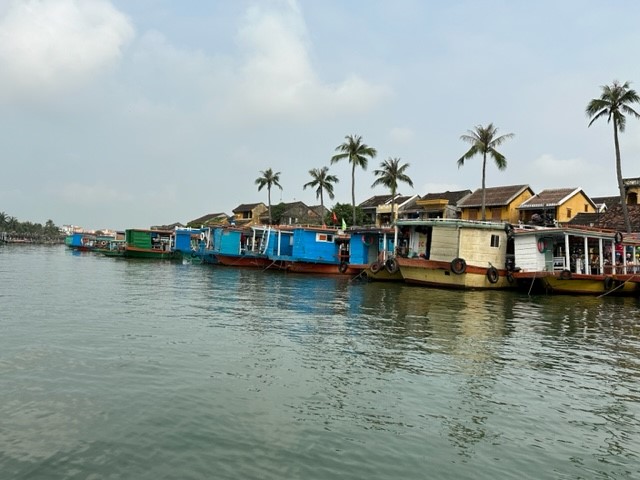
Eventually we arrived at the island. Our first stop was the oldest house, followed by a visit to a gift shop with Buddhist statues and other items and wooden carvings,
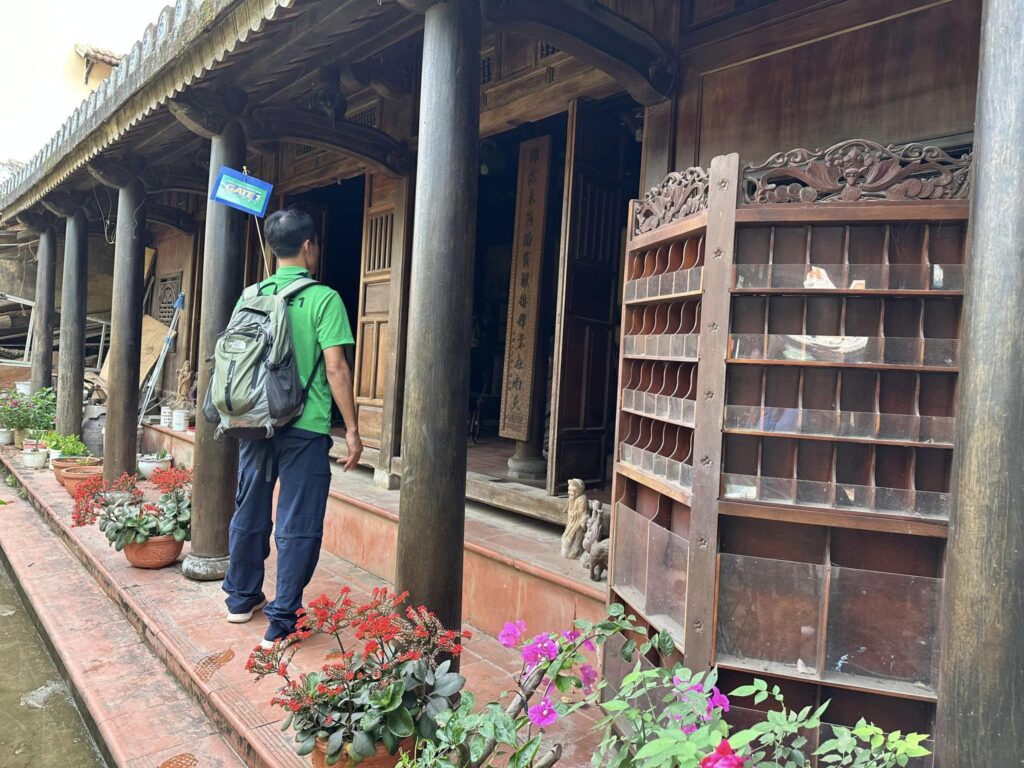
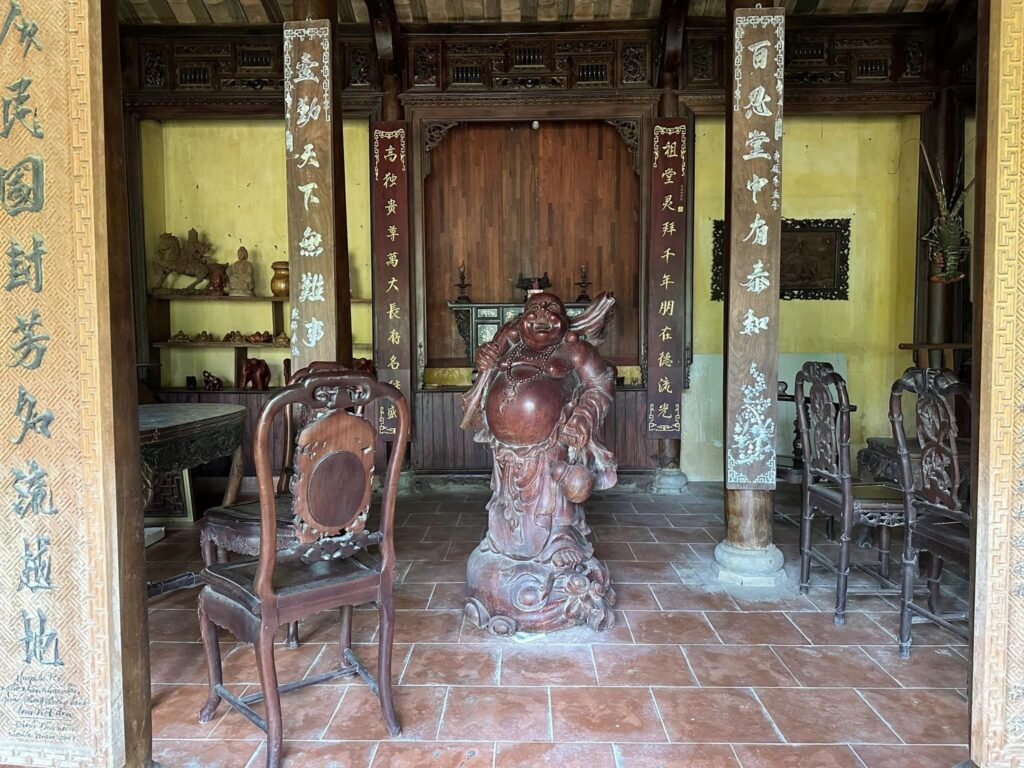
An artisan was carving statues out of wood. As we continued our walk, we entered the market where the local fruits and vegetables are sold.
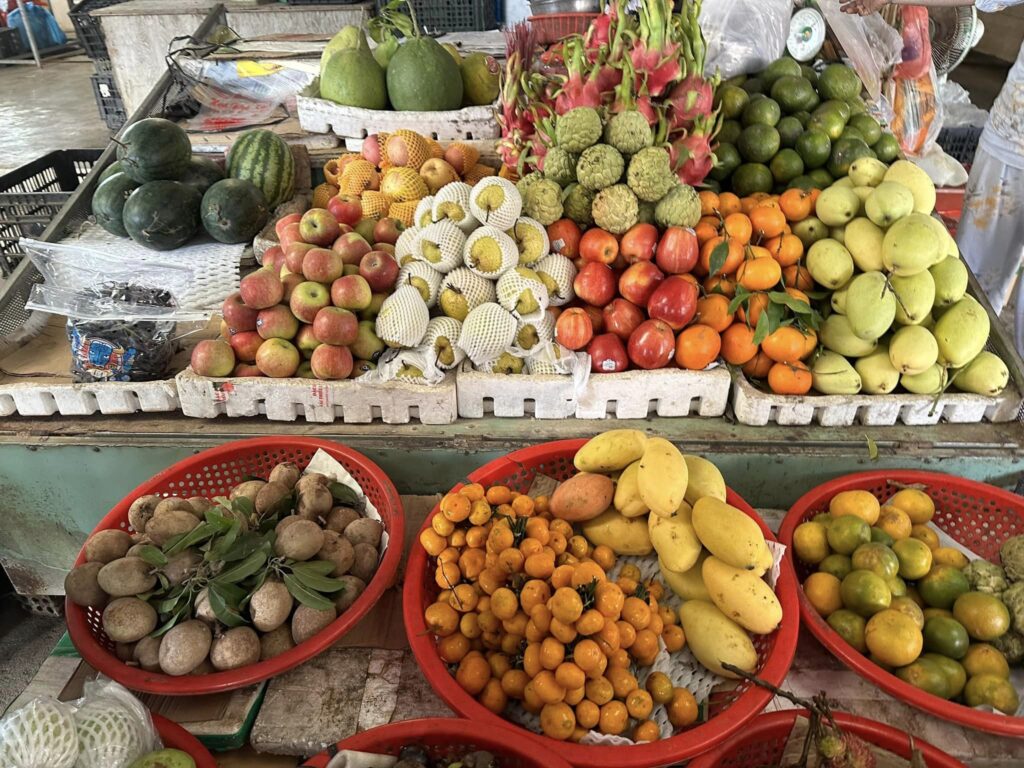
Homes on the island run the gamut from small cottages to spacious residences.
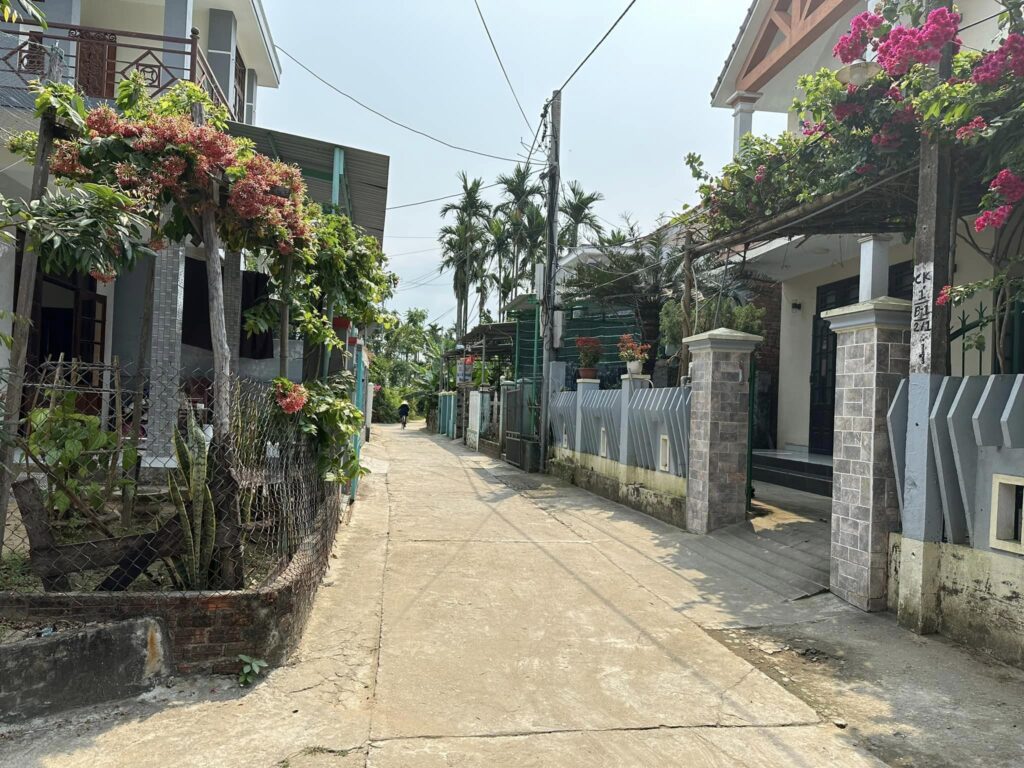
Locals work on shipbuilding and small watercraft repair businesses.
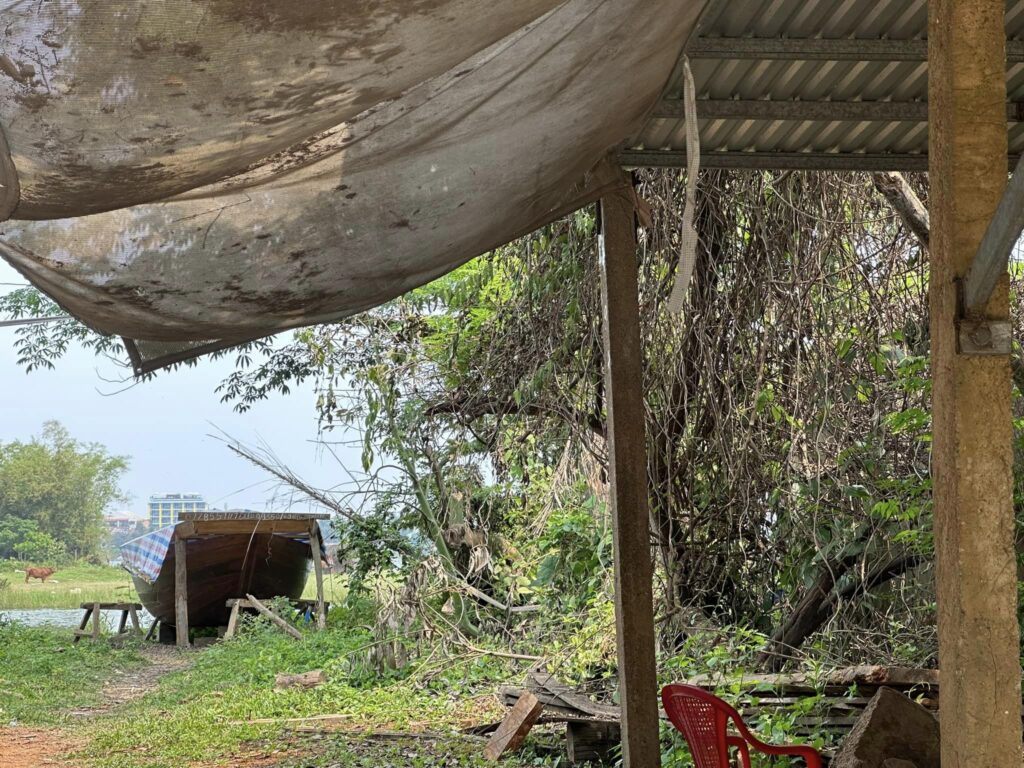
We then re-boarded the small ferry, hopped in the tour bus upon arrival on land, and then headed to our next destination.. Tra Que organic vegetable village. A comical chef instructed us on how to make savory Vietnamese crepe pancakes. I prepared and cooked a vegan version of Vietnamese pancakes for myself, with the chef’s assistance.
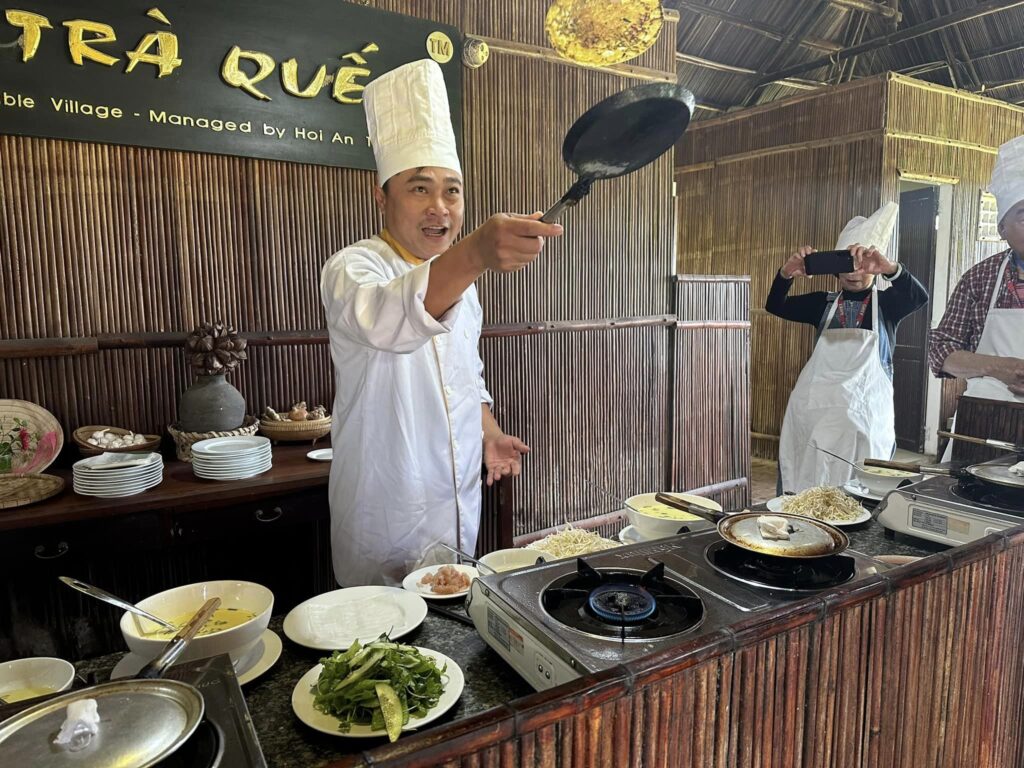
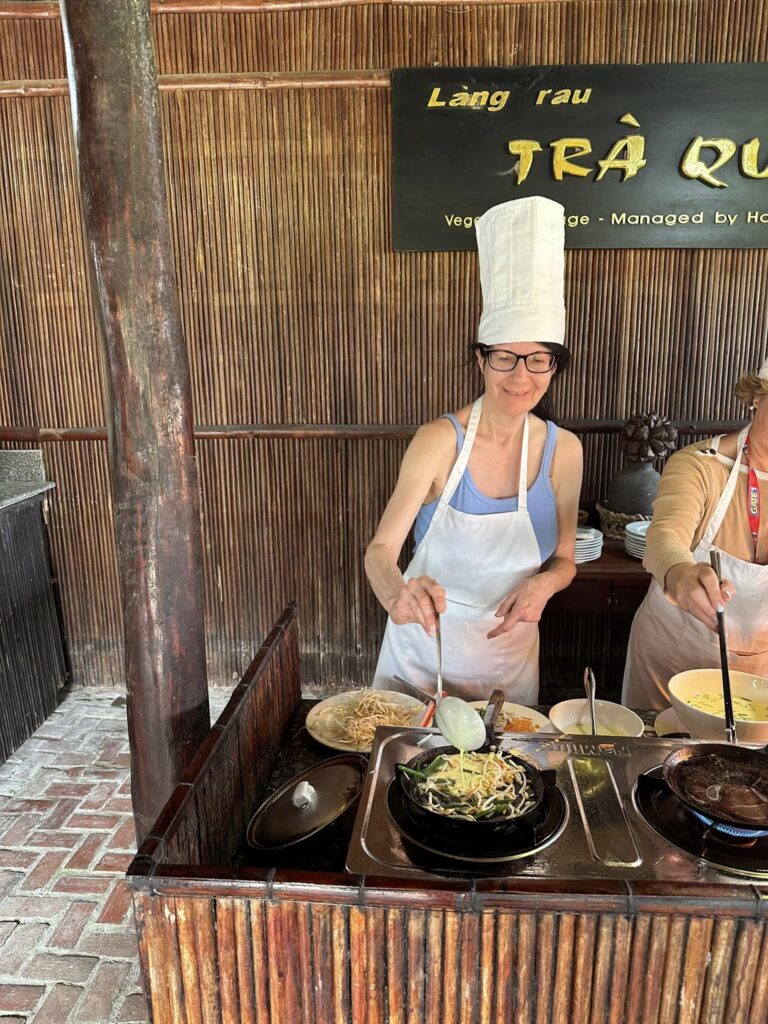
When my pancake had cooked thoroughly, I was then show how to do crepe rolling. First step was to fill the pancake with green fresh herbs and sprouts. Then we rolled the pancake around the toppings. Finally, we dipped the pancake in soy sauce. It was truly delicious!!
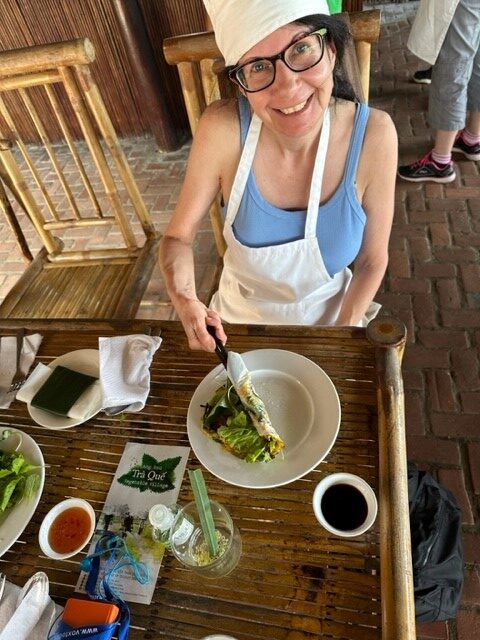
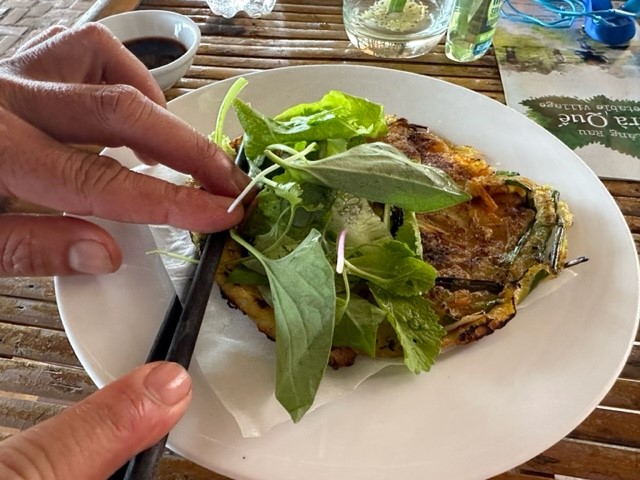
The organic village kitchen prepared a full lunch for us. It consisted of pineapple, a tofu with veggies and rice bowl, salad on a wafer, rolled savory crepes with veggies. Everything was really tasty!!
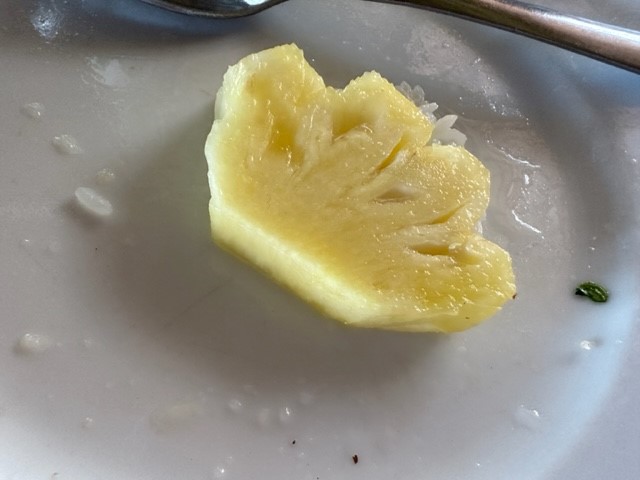
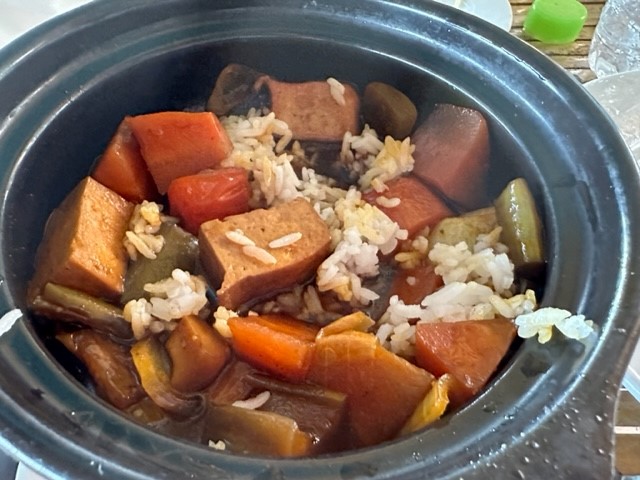
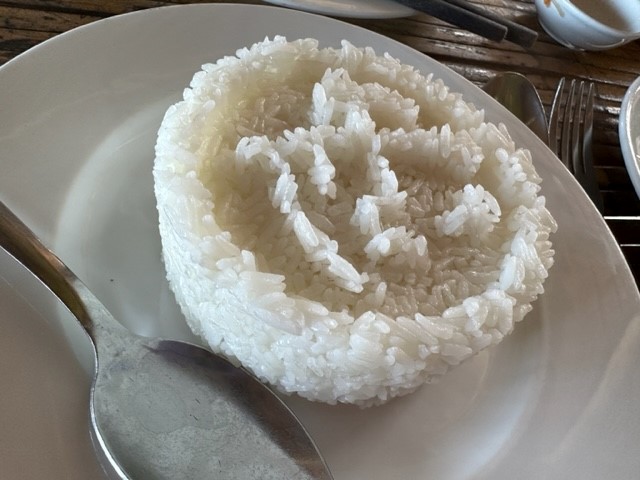
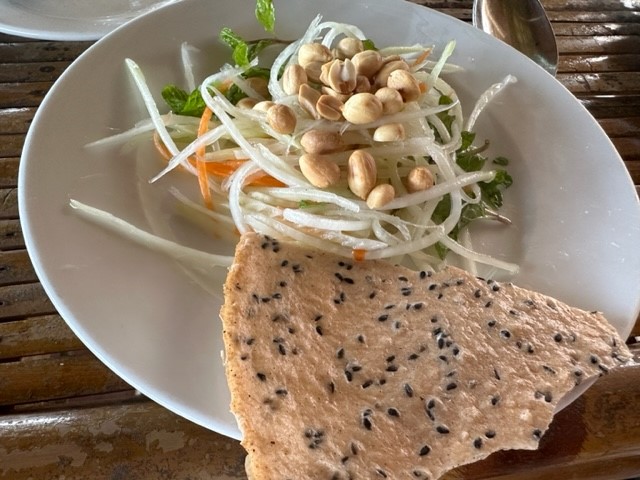
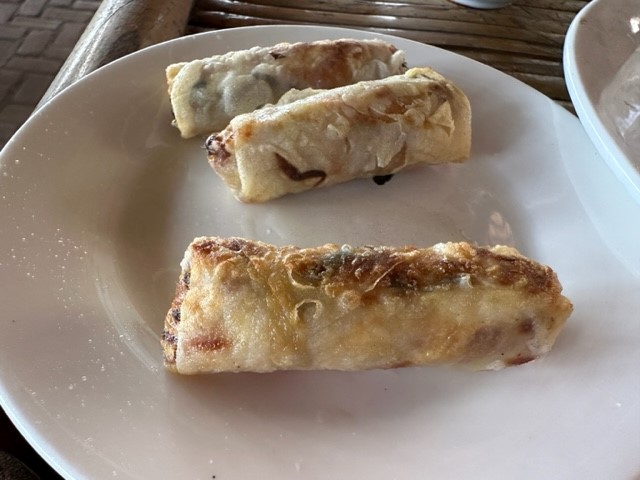
After our mid-day meal, our guide gave us a tour of the organic village. He showed us the process of how to water the crops, by filling two buckets on a horizontal wooden stick, with water, then slightly tilting the buckets to shower the fields.
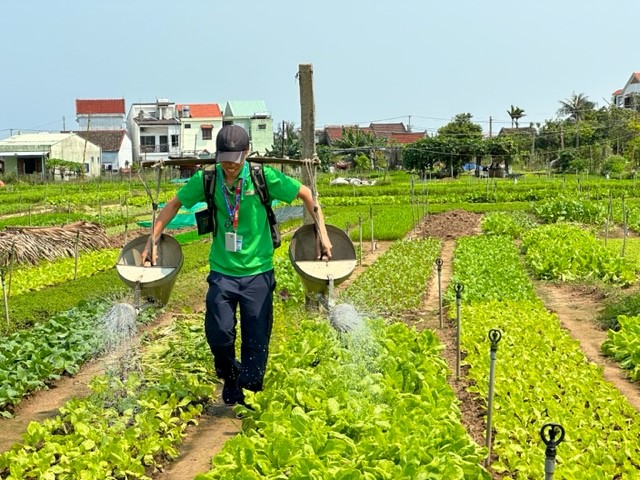
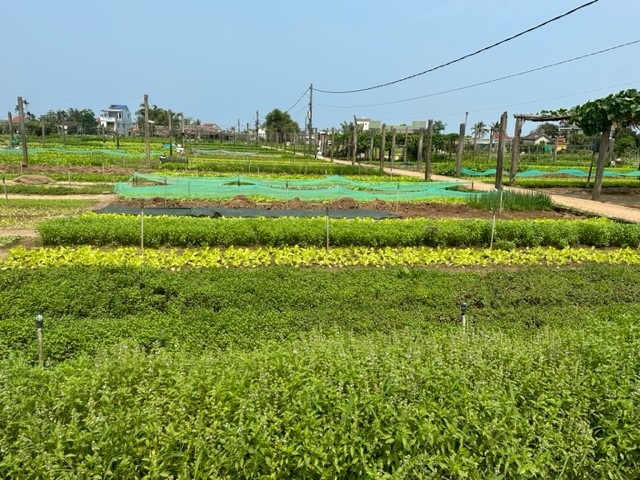
Up arrival back at our hotel, we were given a few hours of free time in the afternoon. I took the shuttle to the Hoi An beach. It is known as one of the top ten beaches in the world. The soft white sand, lengthy beach is stunning!! Thatch, umbrella-covered chairs line the beach for visitors to enjoy the view.
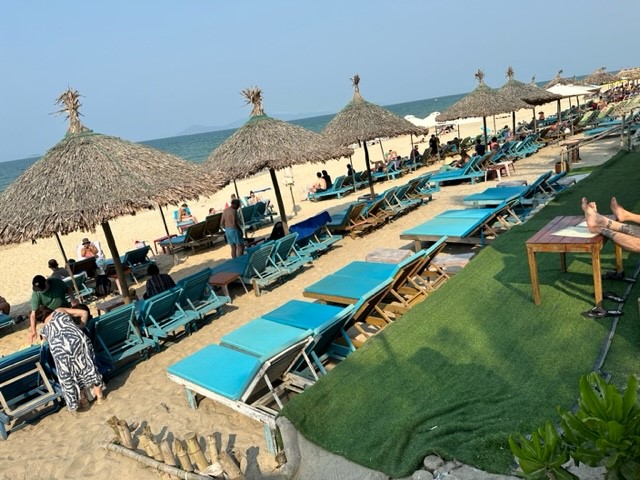
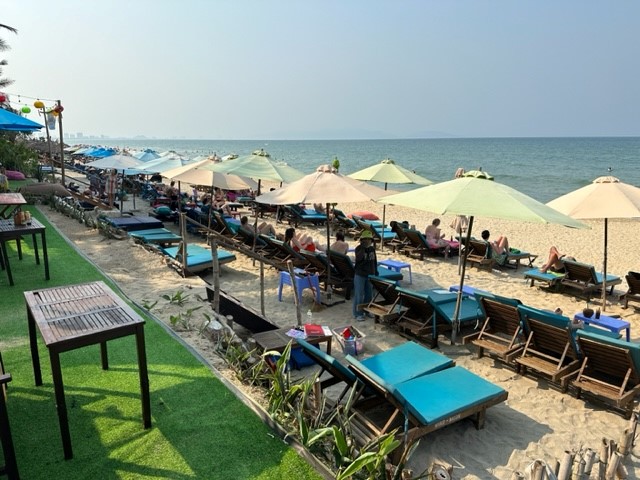
When I arrived back in Hoi Ann town, I decided to dine at “V Vegan” for dinner. My entree was a vegan cau lau with tofu skin and noodles and greens. This is a popular dish in central Vietnam, so I was excited to find a vegan version. My dessert was a yummy banana flambe.
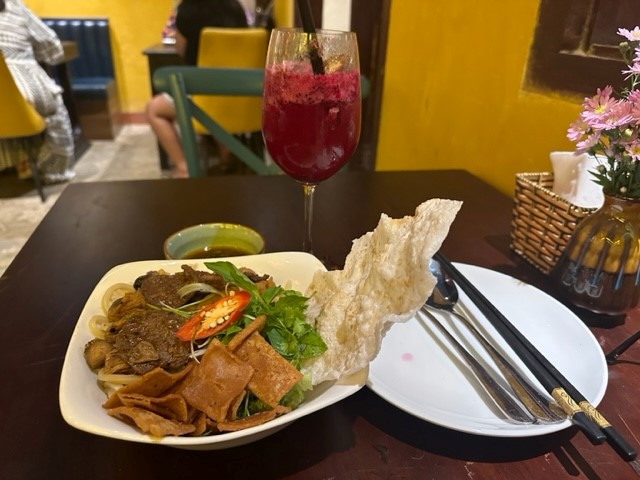
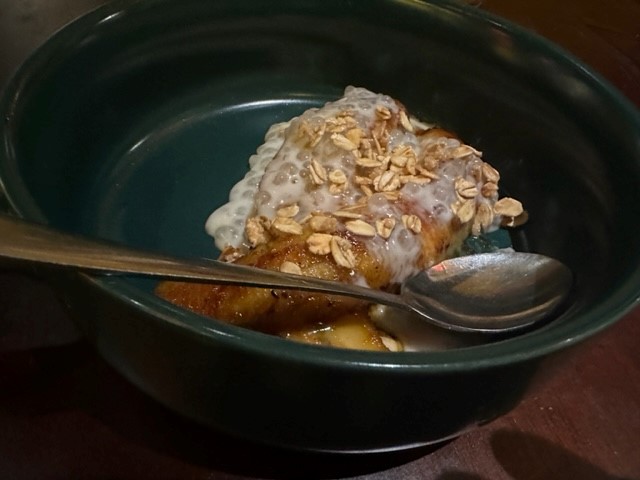
The next morning, I arose early for breakfast at the hotel. My morning meal was a congee(Chinese rice porridge), and some tropical fruit including mango, starfruit, and dragonfruit.
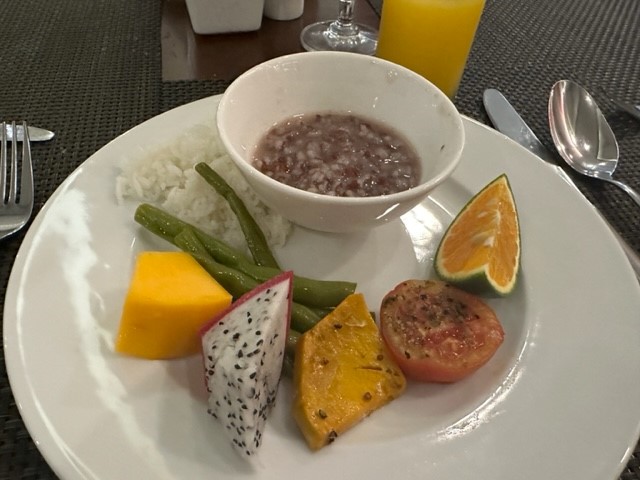
On our way to the city of Hue (our next destination), we made a stop at a marble artisan shop in Da Nang. Everything from huge buddha statues to jewelry, cups, and vases were on display and available for purchase,
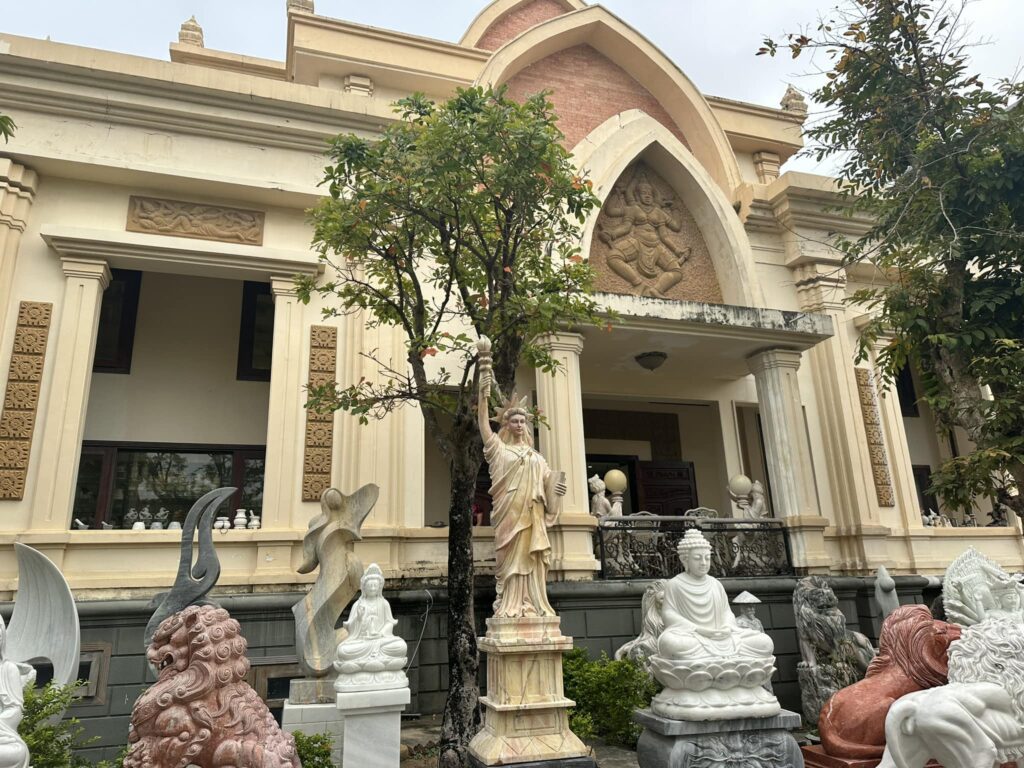
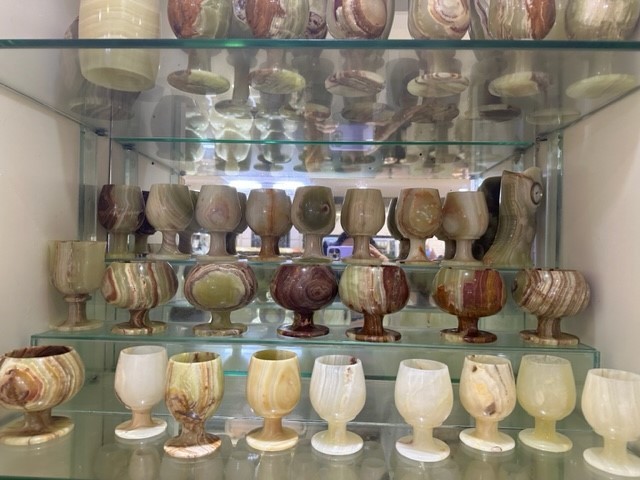
As we proceeded on our drive heading north, we made a photo op stop at the Dragon Bridge in Da Nang. The lengthy bridge is actually shaped like a dragon.
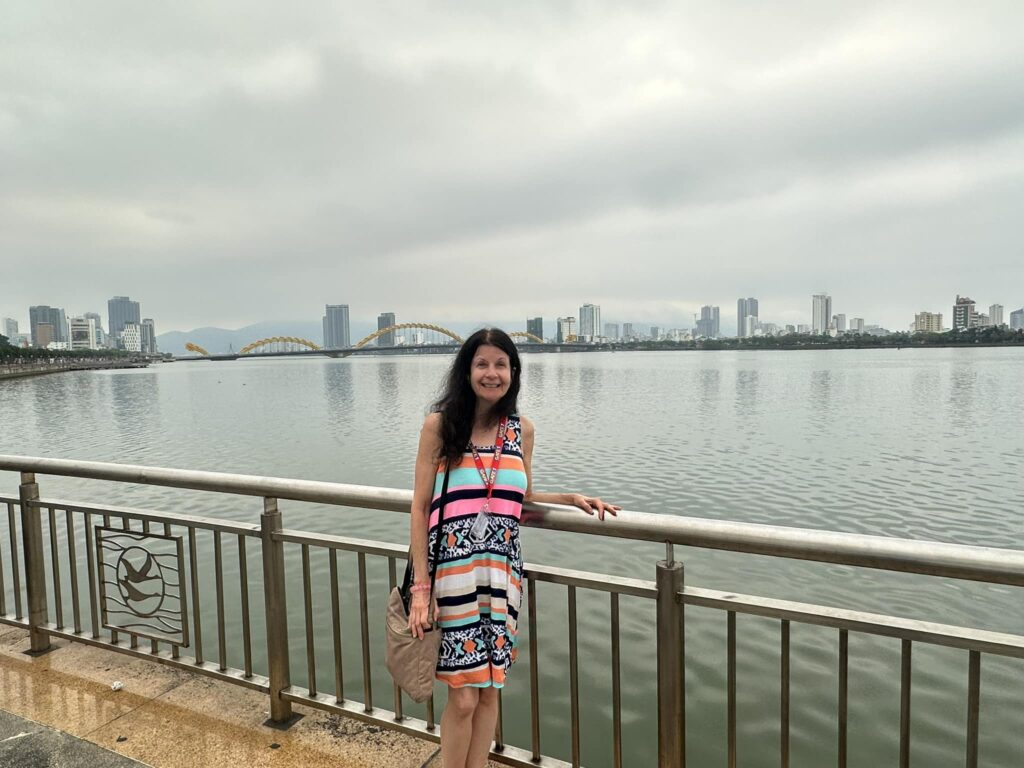
Upon arrival in Hue, I enjoyed a delicious lunch of fried rice, faux vegan ‘meats’, greens, carrots; soup, coconut juice at Hoa Vien veggie and organic restaurant.
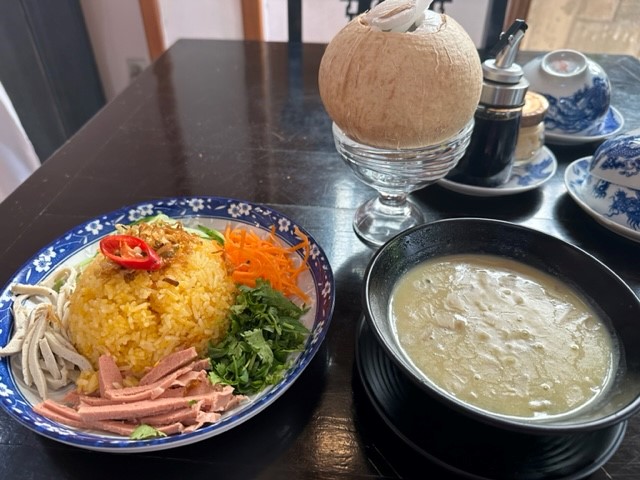
Next up was our group tour of the major attractions in Hue. We visited the Citadel (Royal City) containing the King’s Palace for the imperial family, shrines(19th century), and gardens!!
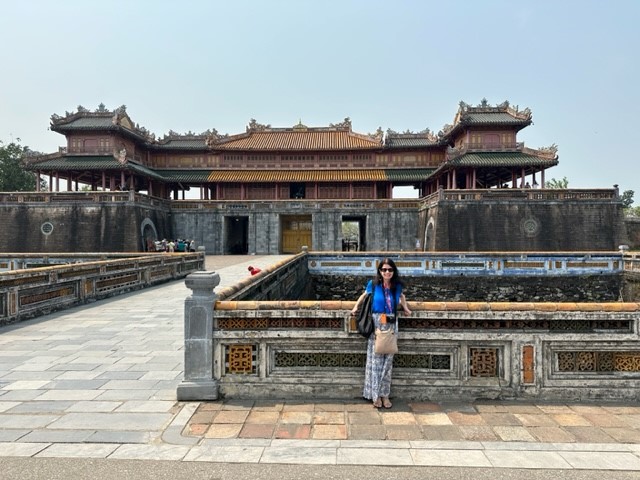
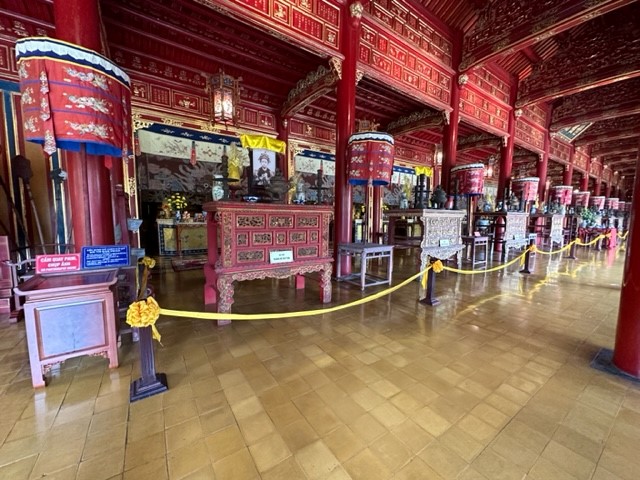
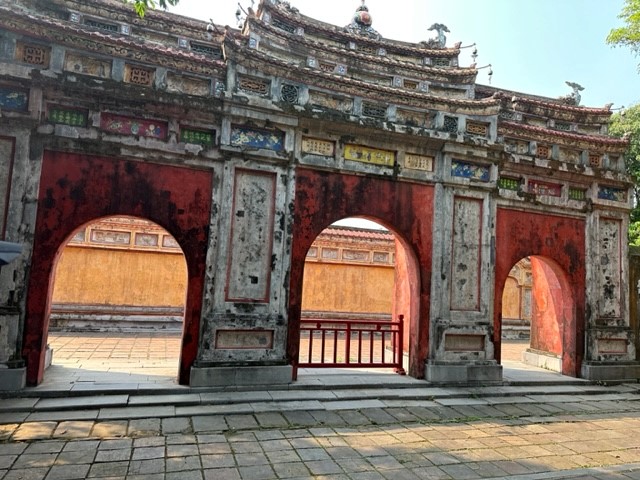
During the late afternoon/early evening, we enjoyed an exciting rickshaw ride around the streets of Hue, passing by shops, markets, and city center buildings.
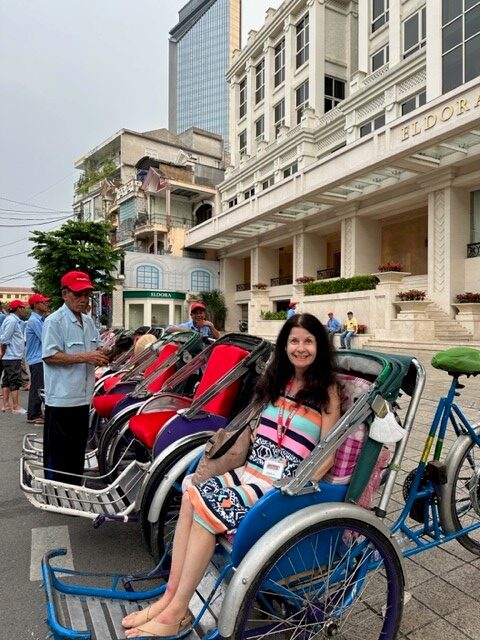
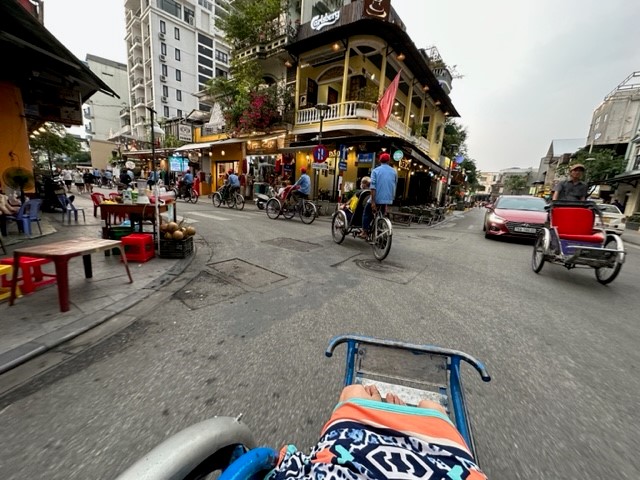
Our evening meal was an authentic Hue-style “Royal Feast” dinner at the Citadel. My dinner included mango juice, fried rice with carrots, green, and tofu; noodles on a wafer, a veggie crepe, veggie soup, mushrooms, bananas, and a sweet dessert formed into flowers and veggies in a vase. The fried rice entrees were creatively shaped into turtle forms, with carrots as its neck, head, and feet; while another dish was created to resemble a rooster with its body being a carved pineapple.
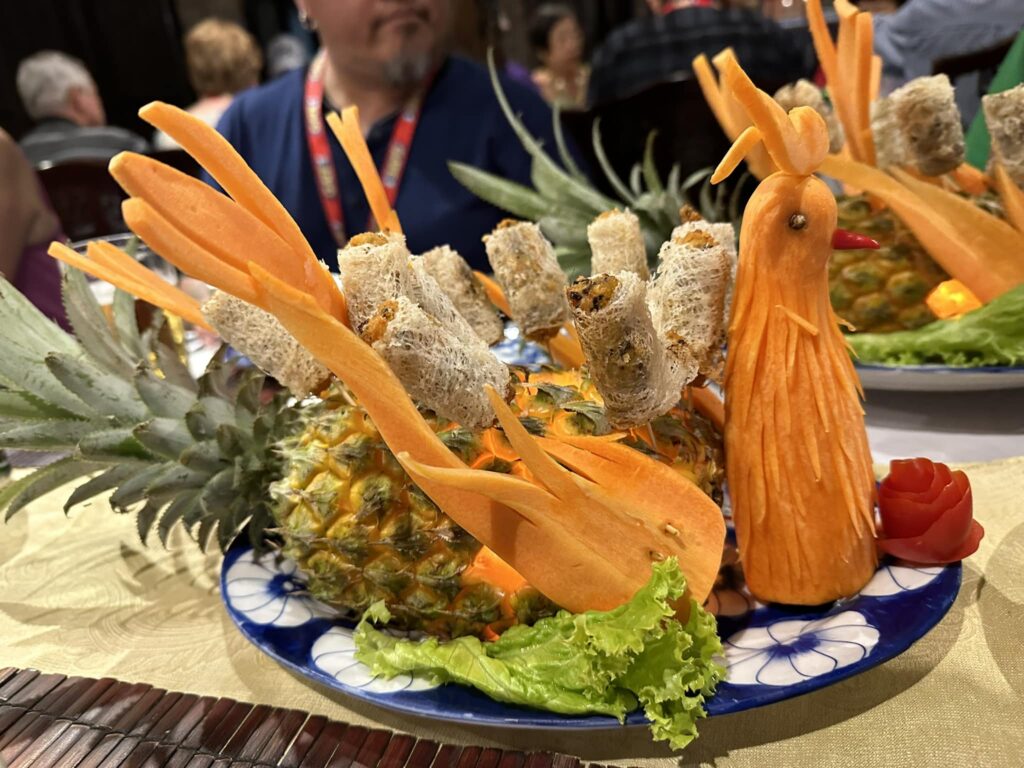
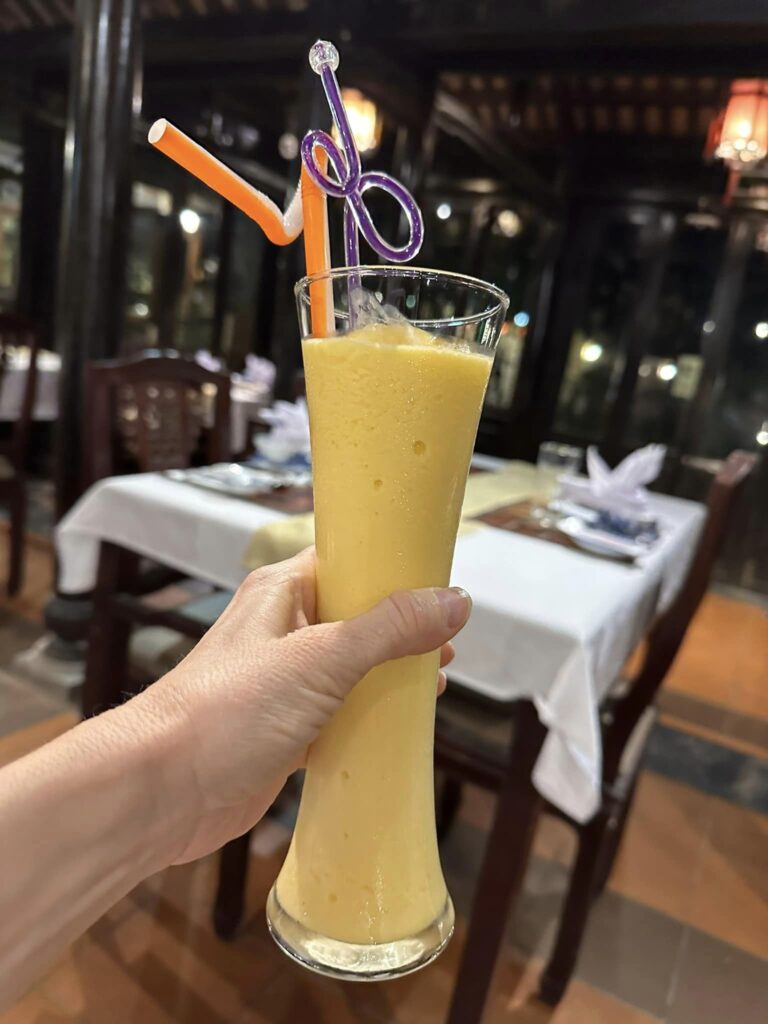
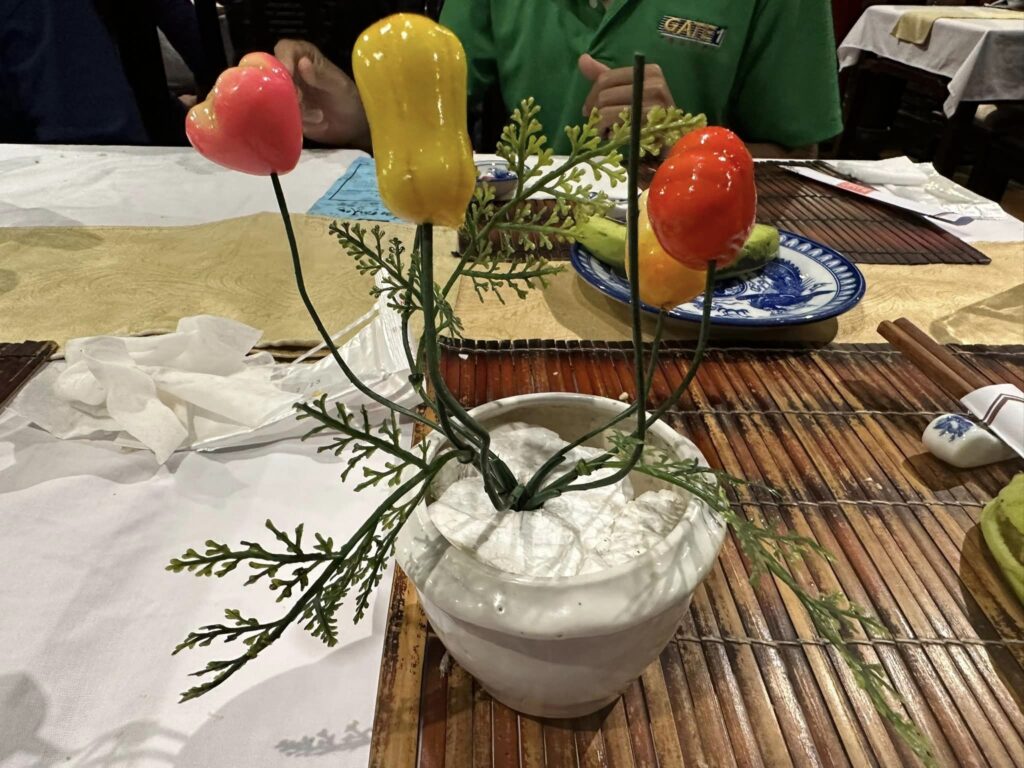
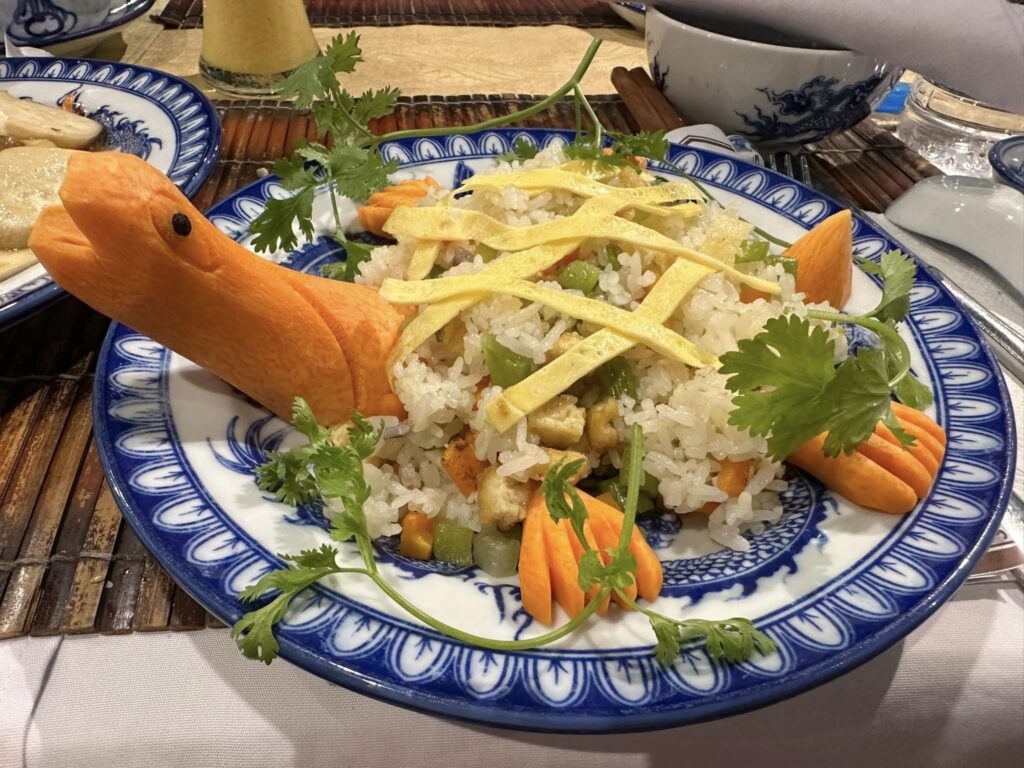
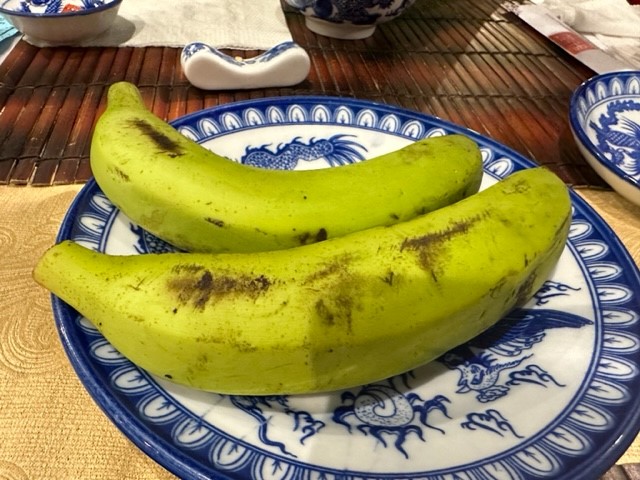
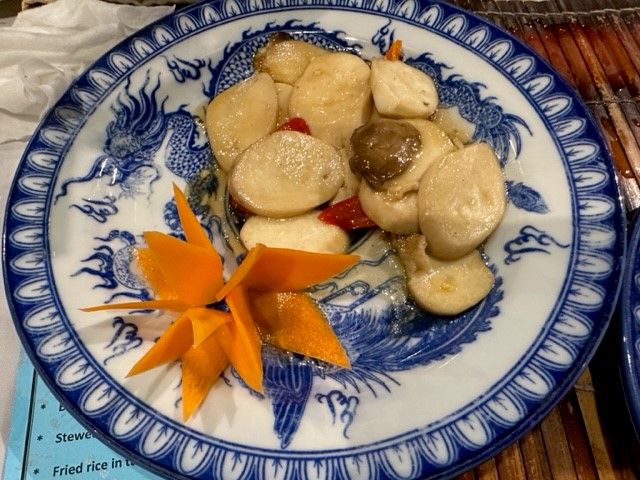
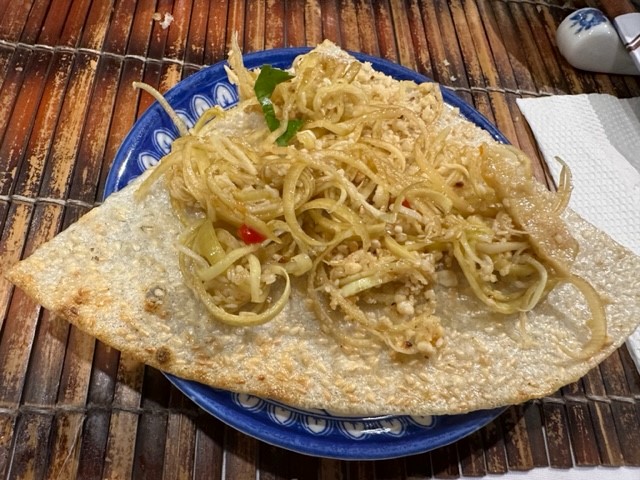
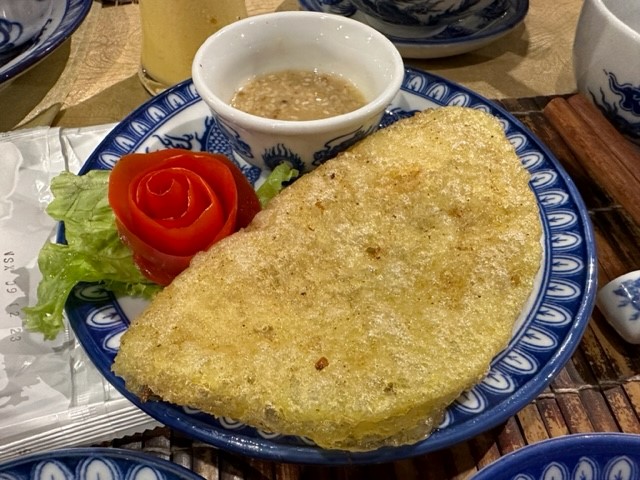
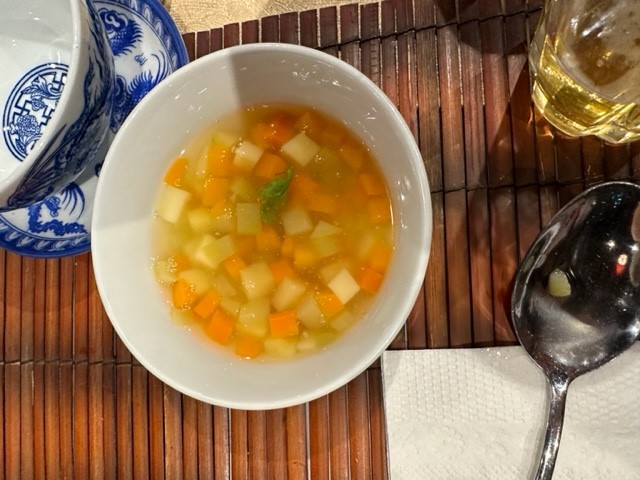
Now it was time to call it a night. The next morning, my group had breakfast at the hotel in Hue. My meal included passionfruit, dragonfruit, pineapple, congee, polenta cakes, and some berry fruit juice. All of my hotels in Vietnam provided really fresh and wonderful breakfast foods.
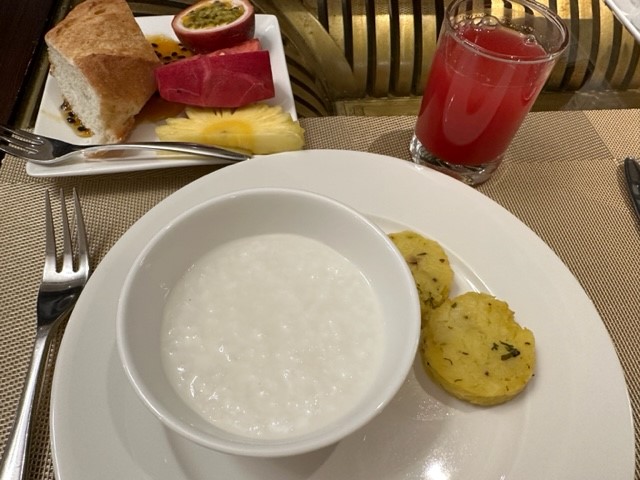
Our group then headed to the docks for a Dragon boat ride on the Perfume River in Hue. We appreciated the fun photo op on the edge of the intricately painted dragon image of the boat’s front platform.
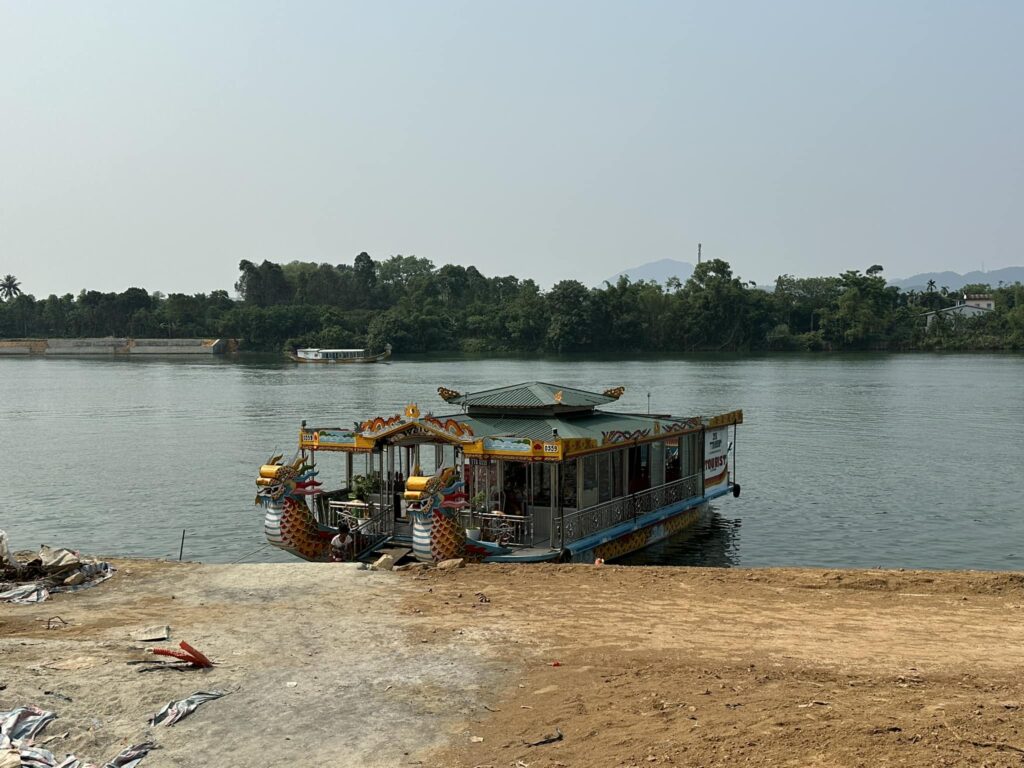
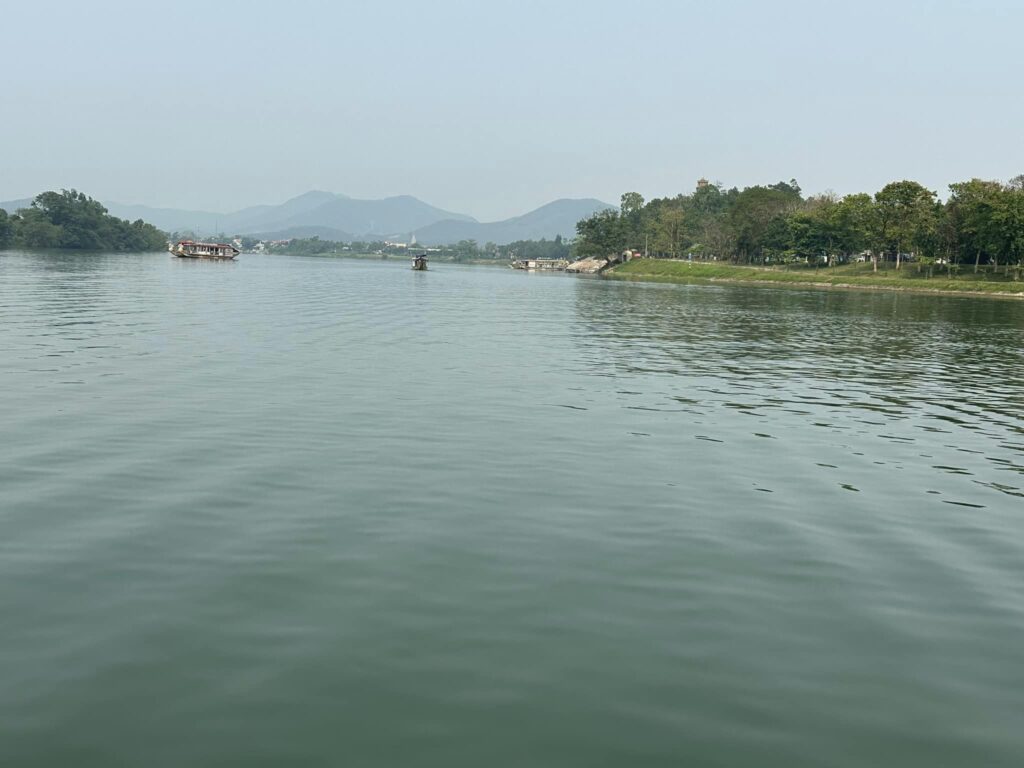
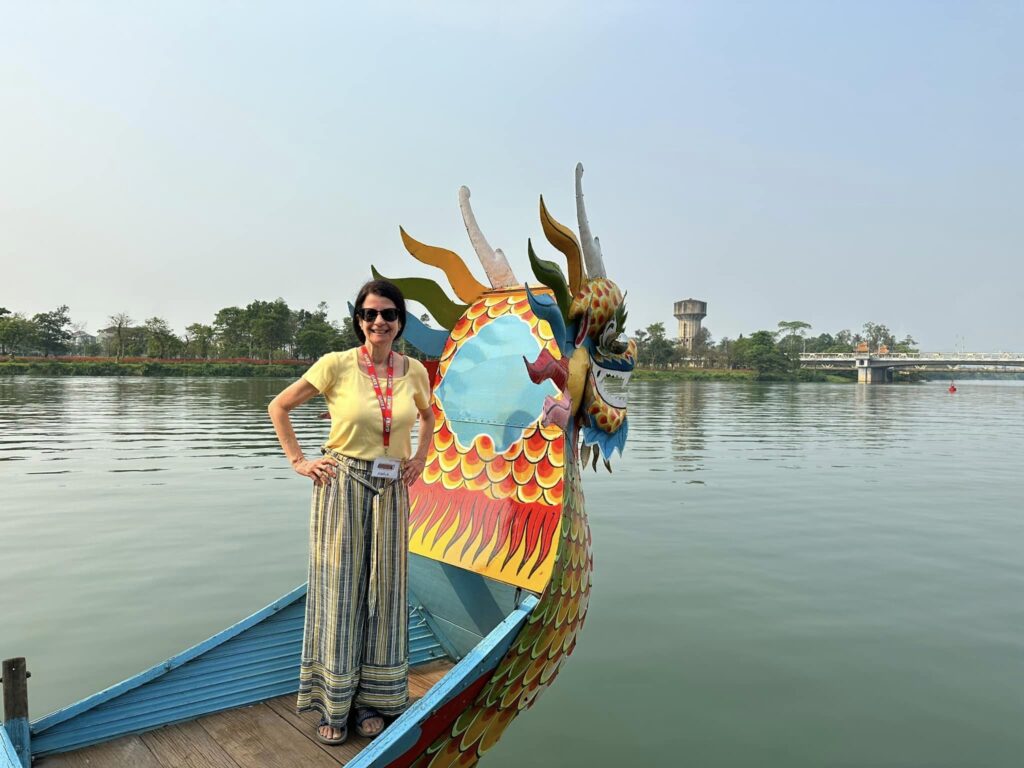
We paid a visit to the Thien Mu Pagoda, along the Perfume River in Hue. Our group walked through the worship section and the religious offering areas within the sacred Buddhist temple!! The grounds include a seven story pagoda which is the unofficial symbol of the city.
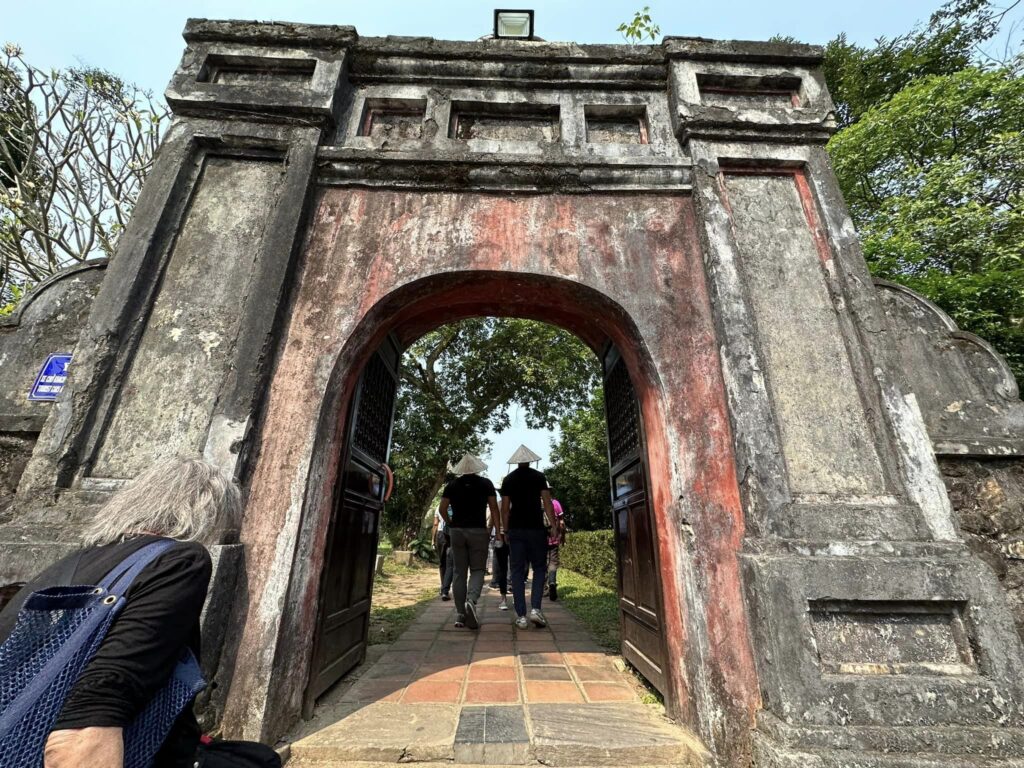
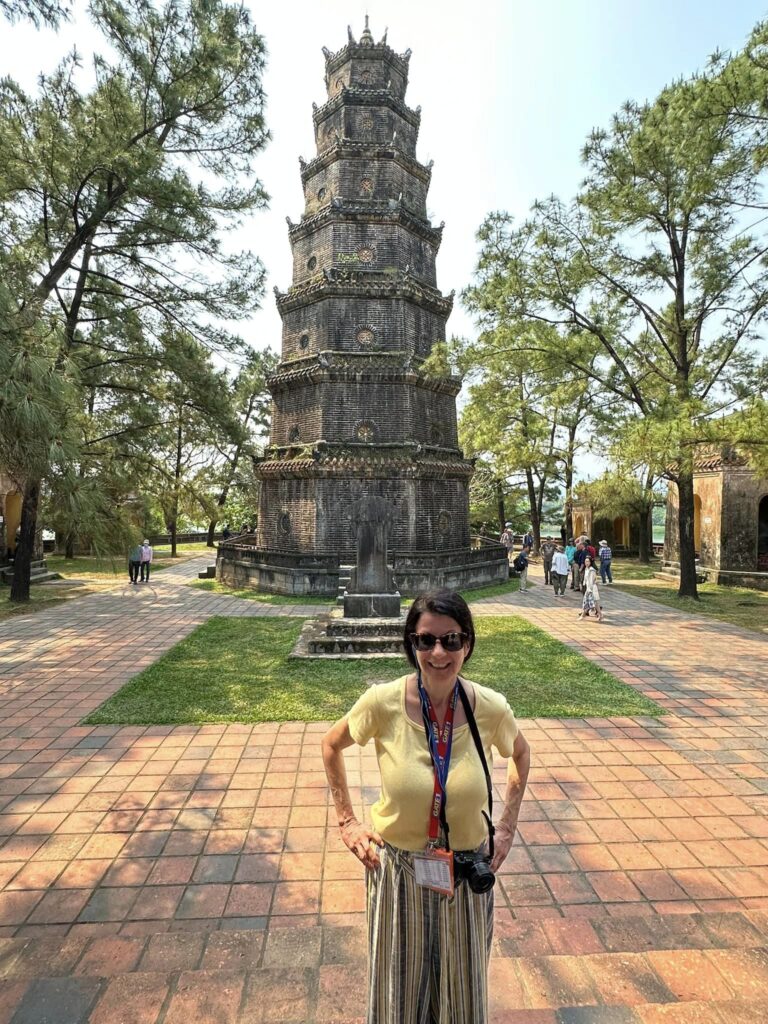
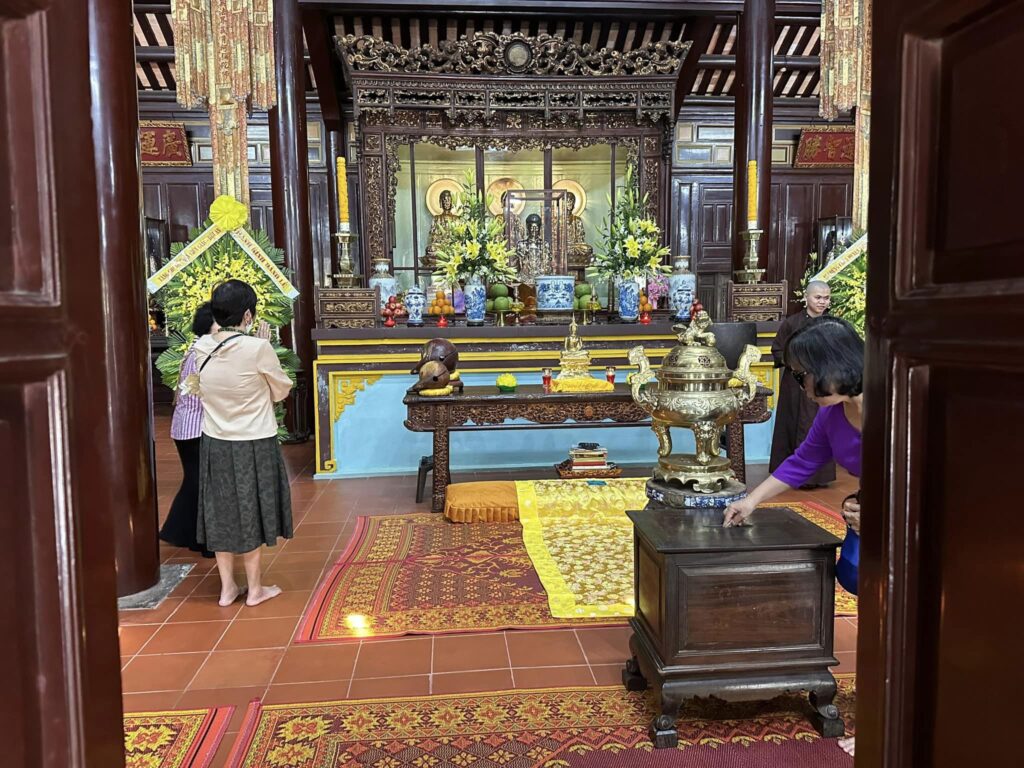
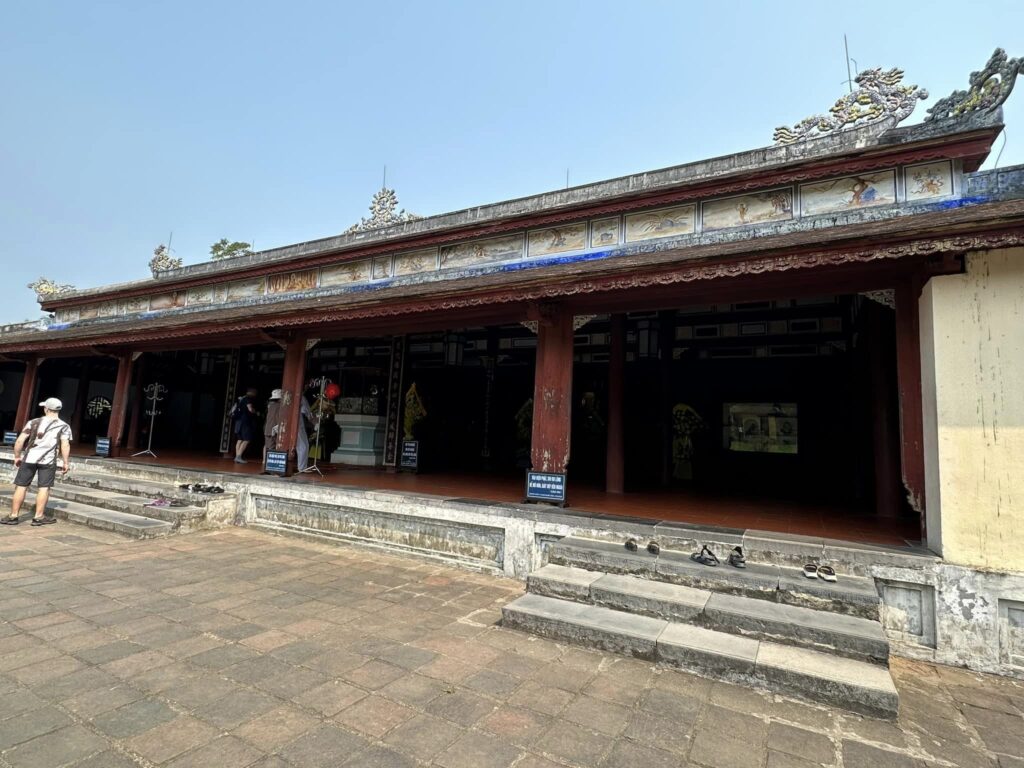
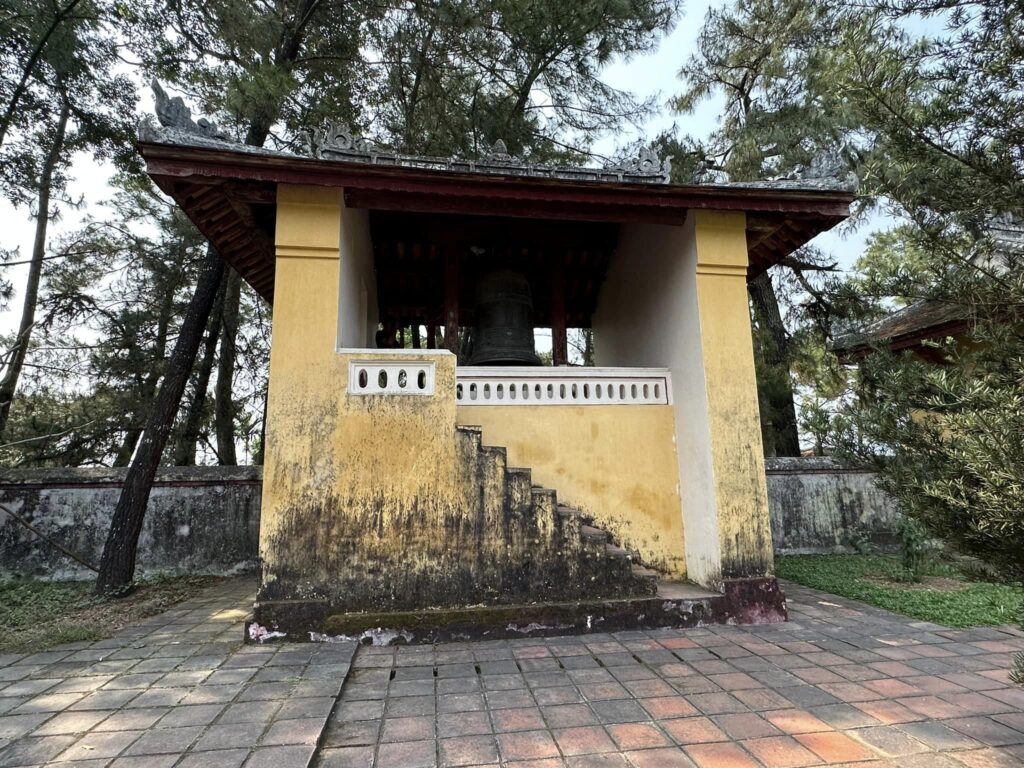
After we left the pagoda, we paid a visit to an artisan craft shop along the route. Skilled artisans gave an incense-making demo(shaping the clay water mixture into long tube then rolling/thinning it & applying color to tip with different scents) and also showed us a bamboo conical hat-making demo(flattening Bamboo leaves, drying in sun, placing cutout paper (purple)under it for design, sewing the leaves together around the hat brim, then painting images on it)!!
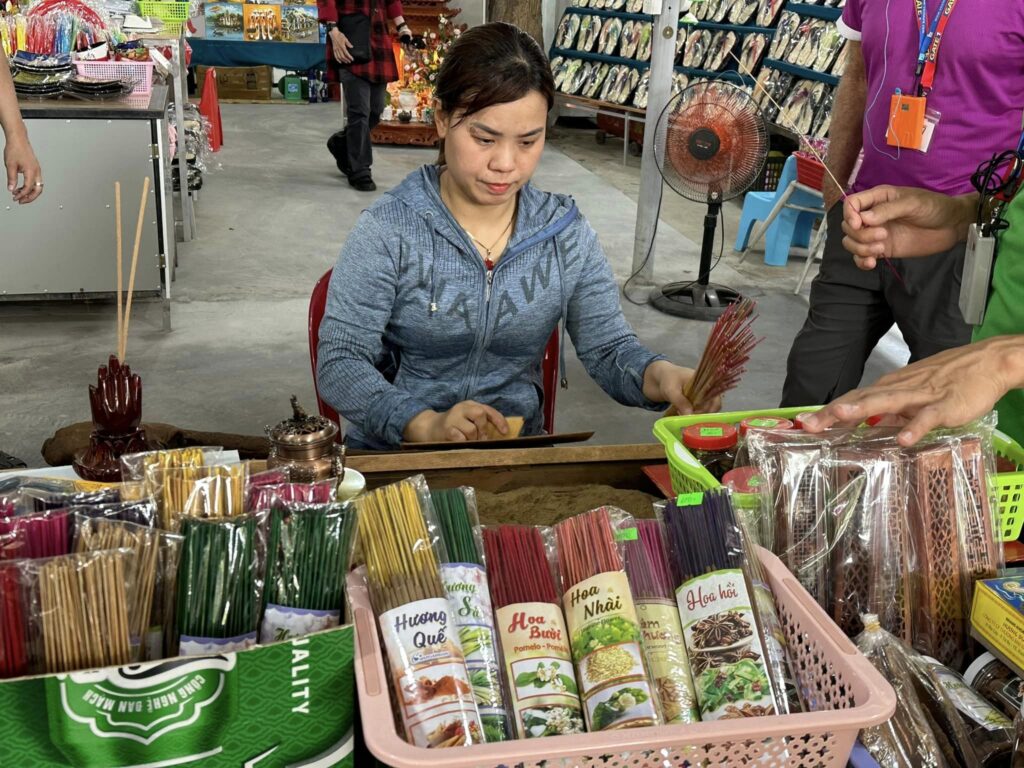
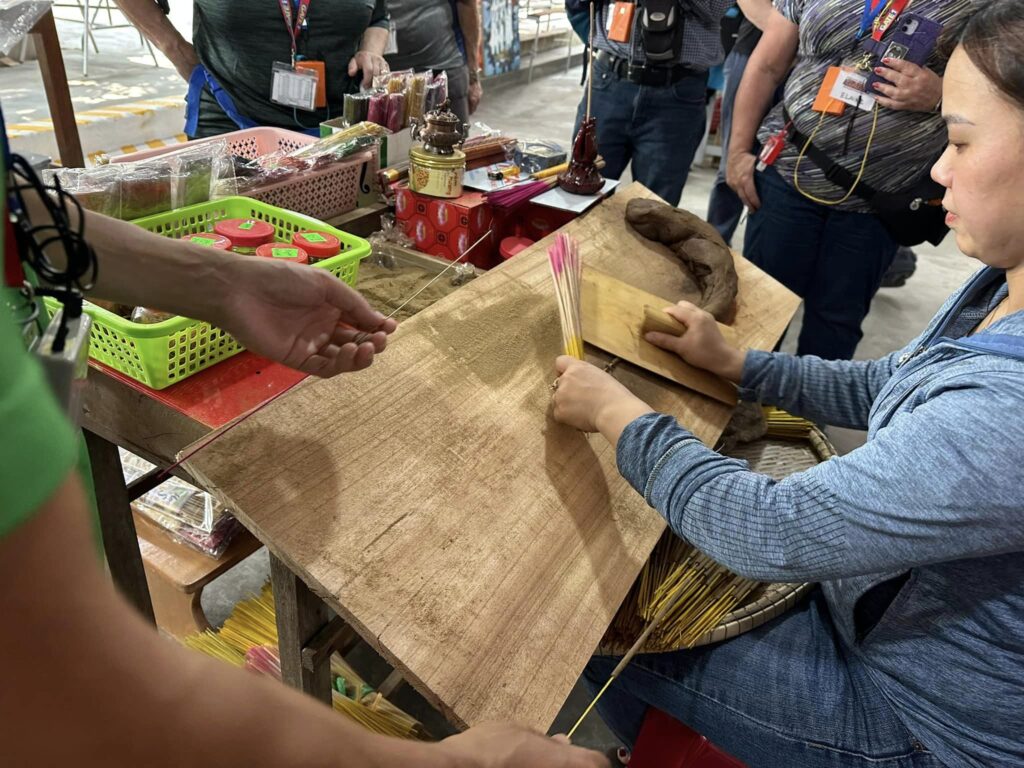
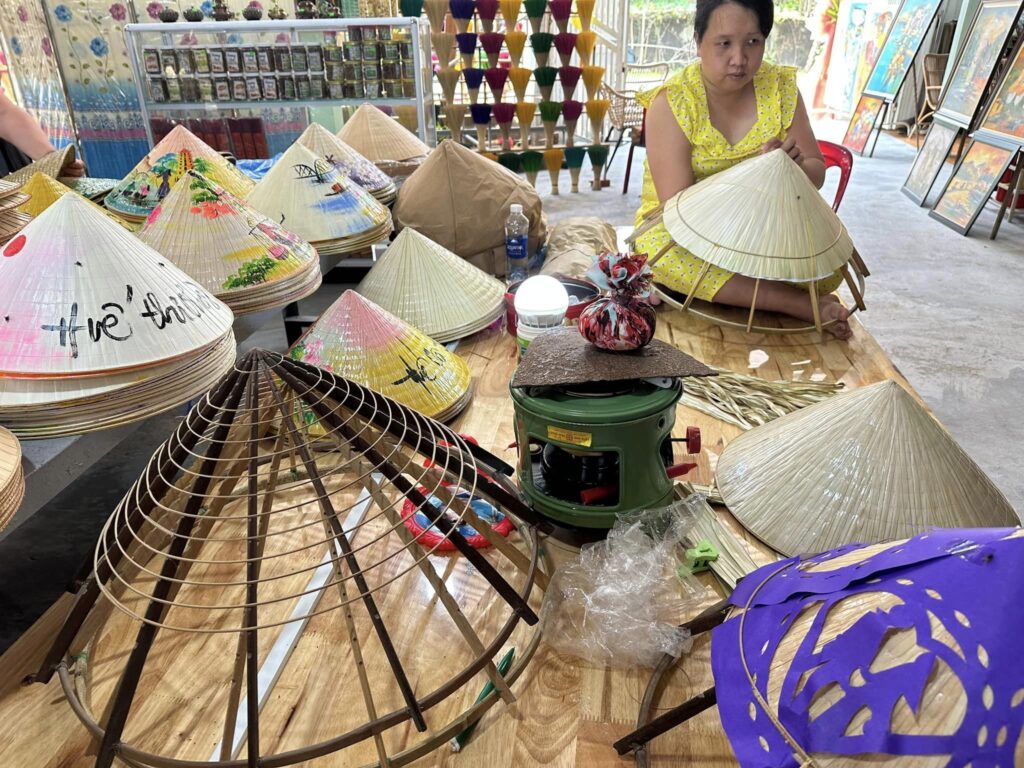
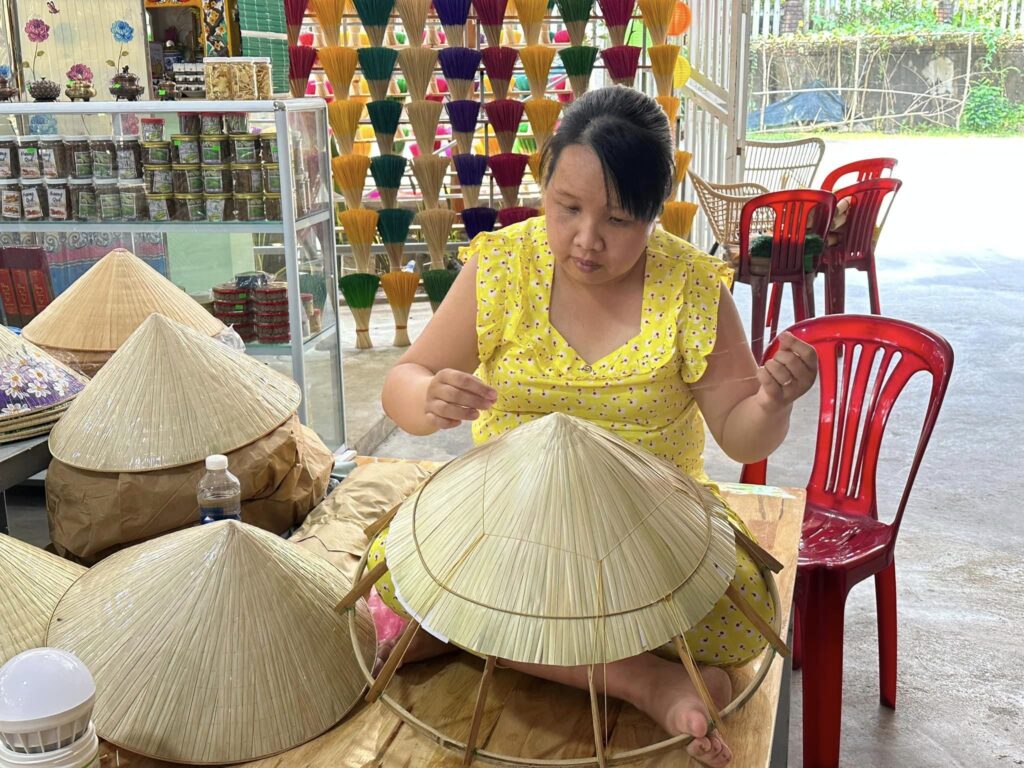
Next on our itinerary was a visit to Tu Doc Tomb, also in the city of Hue.
We visited the 19th century King’s tomb, pagoda with worship area & offering, and also saw the opera with his throne and carriage and seating box. A stone tablet outside commemorates his life story!!
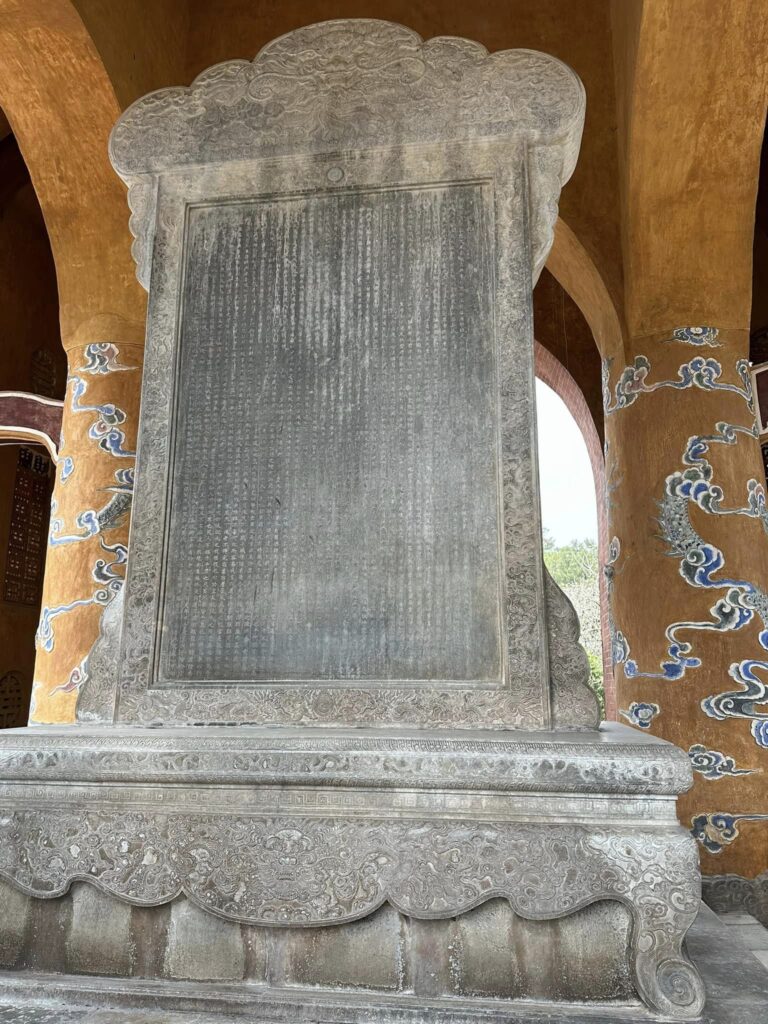
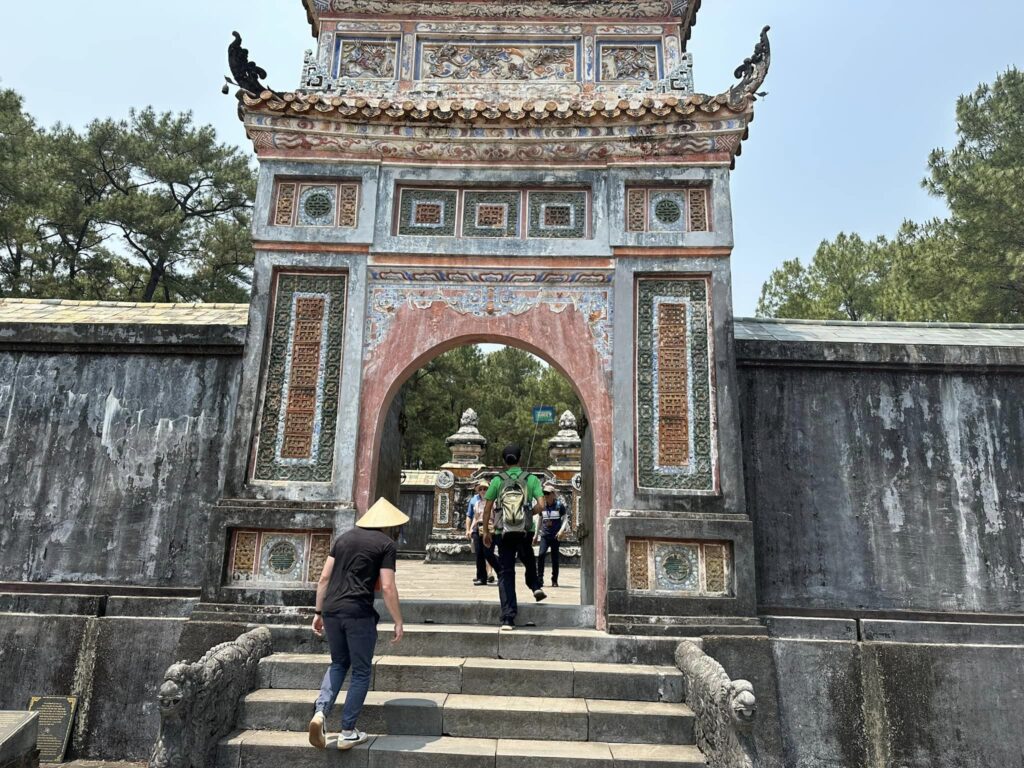
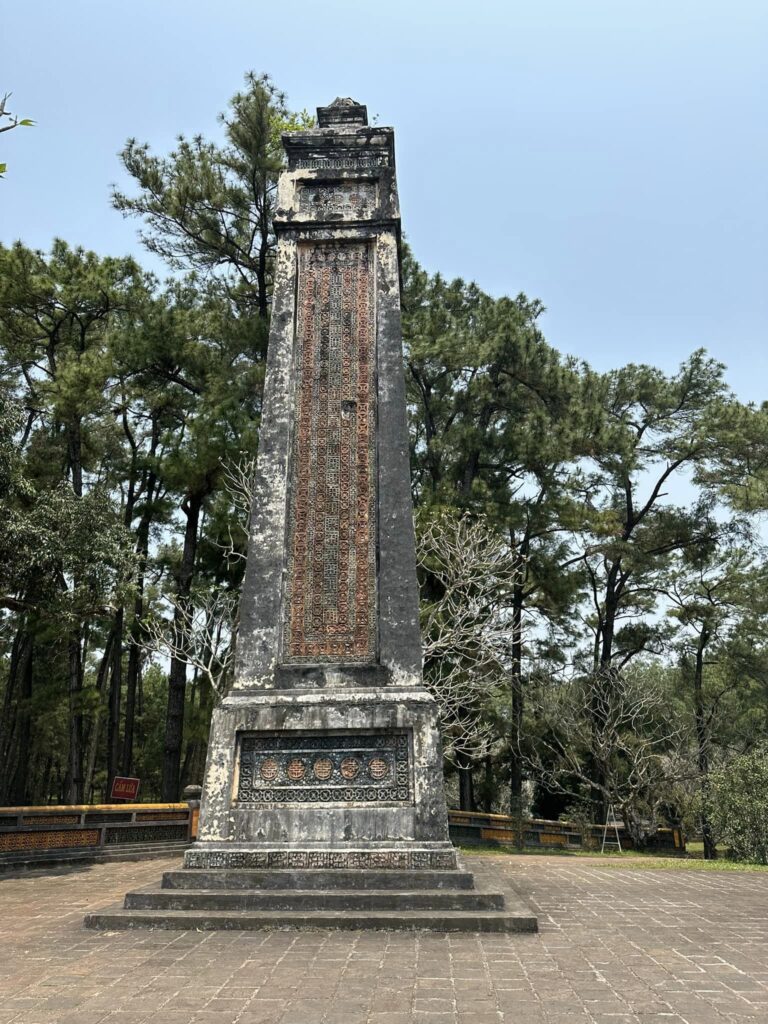
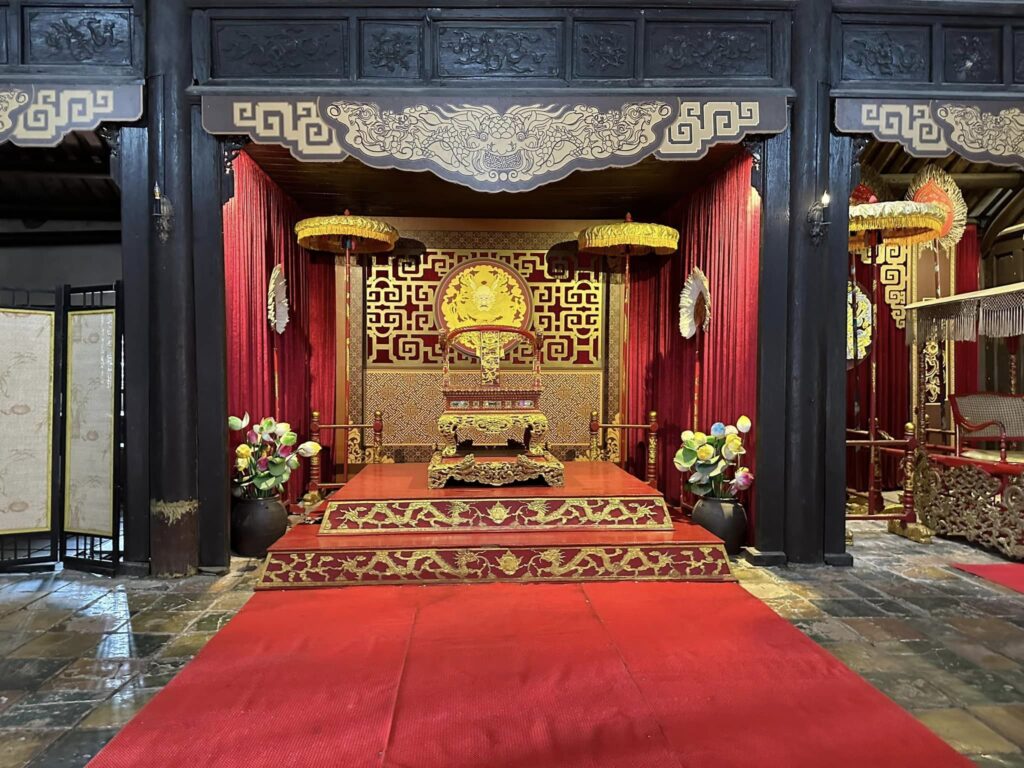
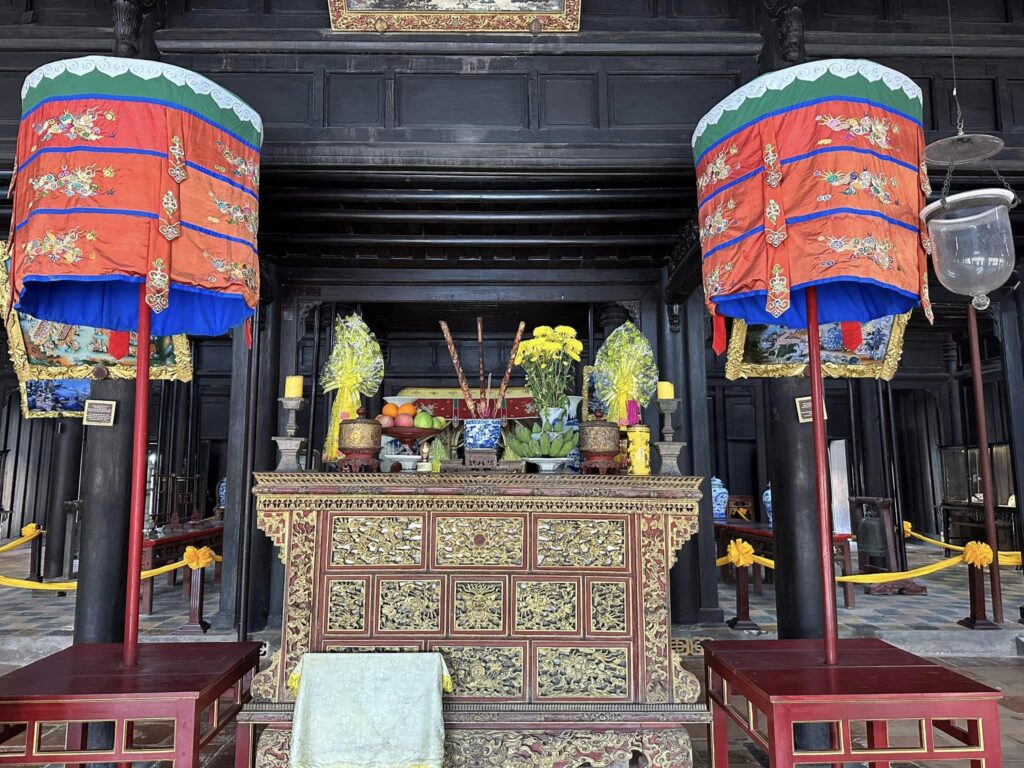
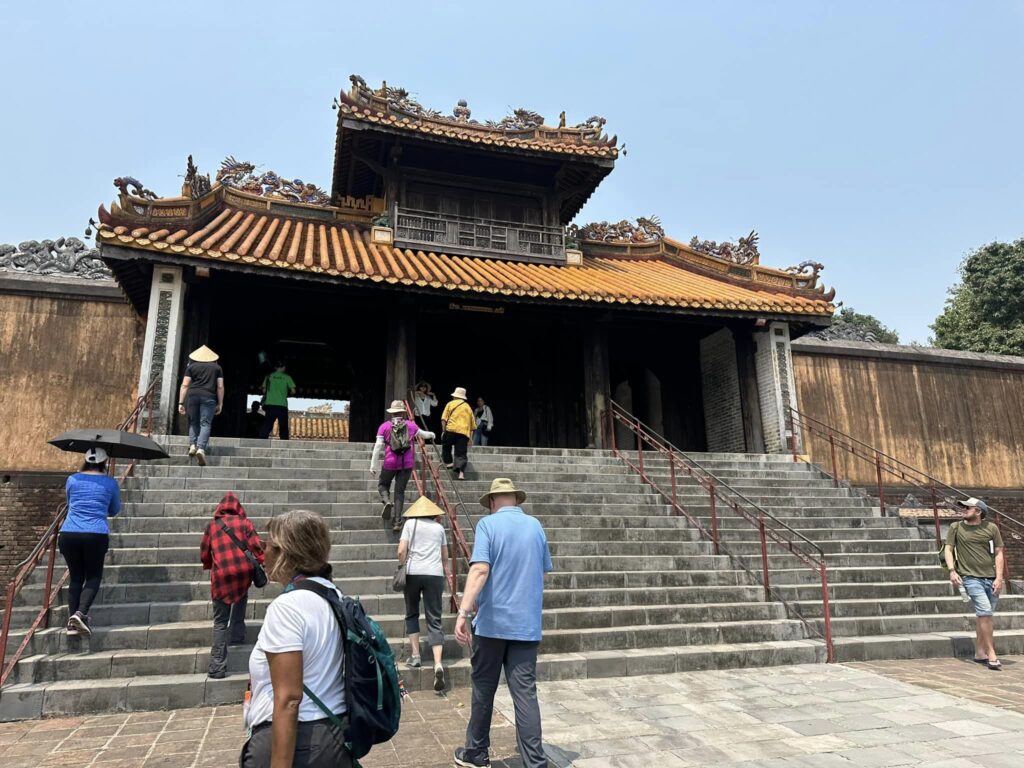
Our lunch in Hue was served to our tour group by Buddhist nuns at their Dong Thien Pagoda. The female monk serving us. had a traditional shaven head and wearing simple, gray attire. We ate shredded fig salad on rice wafers, veggie wontons, mushroom soup, tofu with spicy sauce, rice, string beans, and banana!! It was a satisfying vegan meal. Everywhere we dined with our tour group, my guide made certain that the meal options were vegan or could be altered to be vegan for me. Most of the side dishes and entrees throughout my trip were indeed naturally vegan, as in the greens, vegetables, soups, and grains.
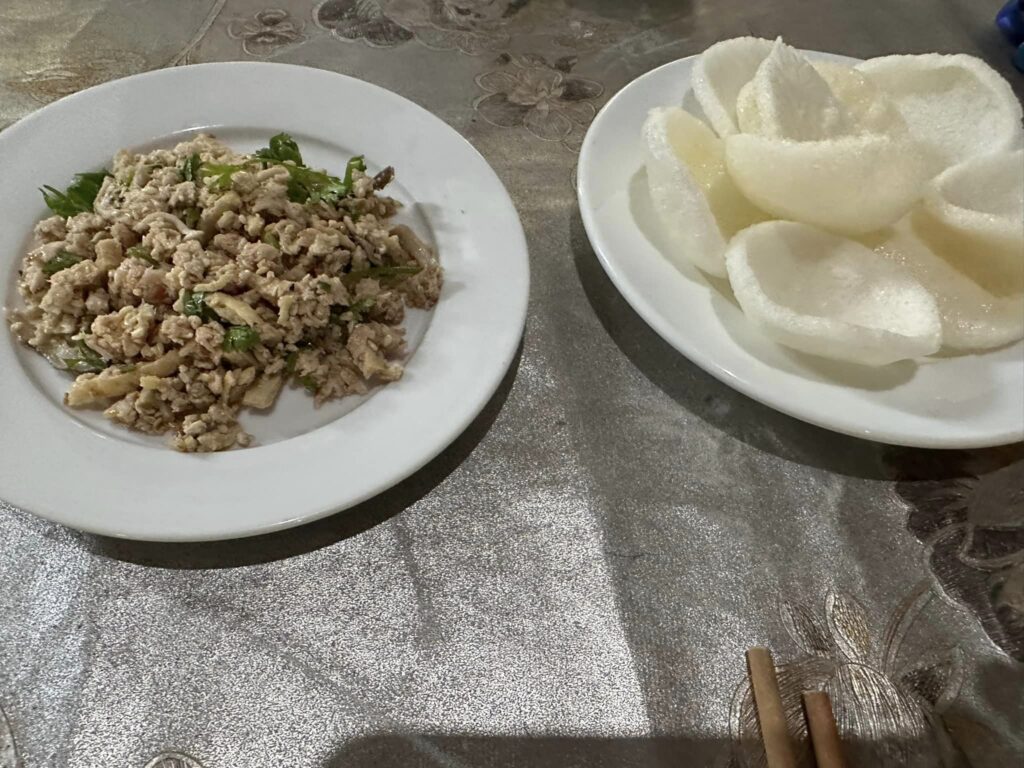
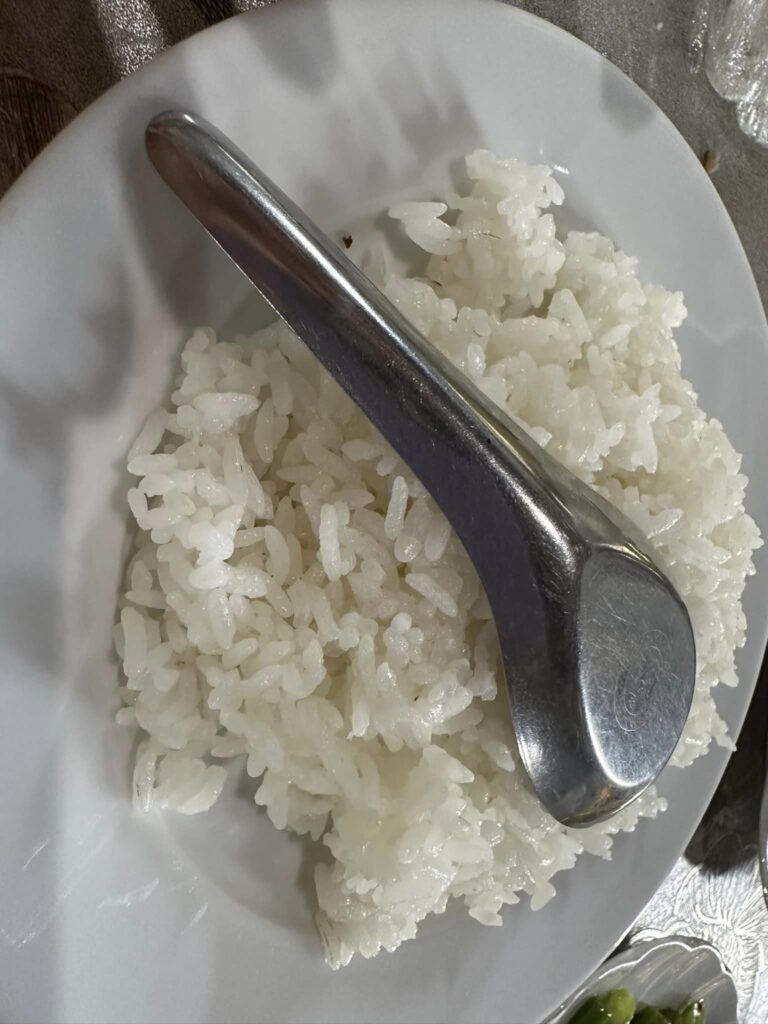
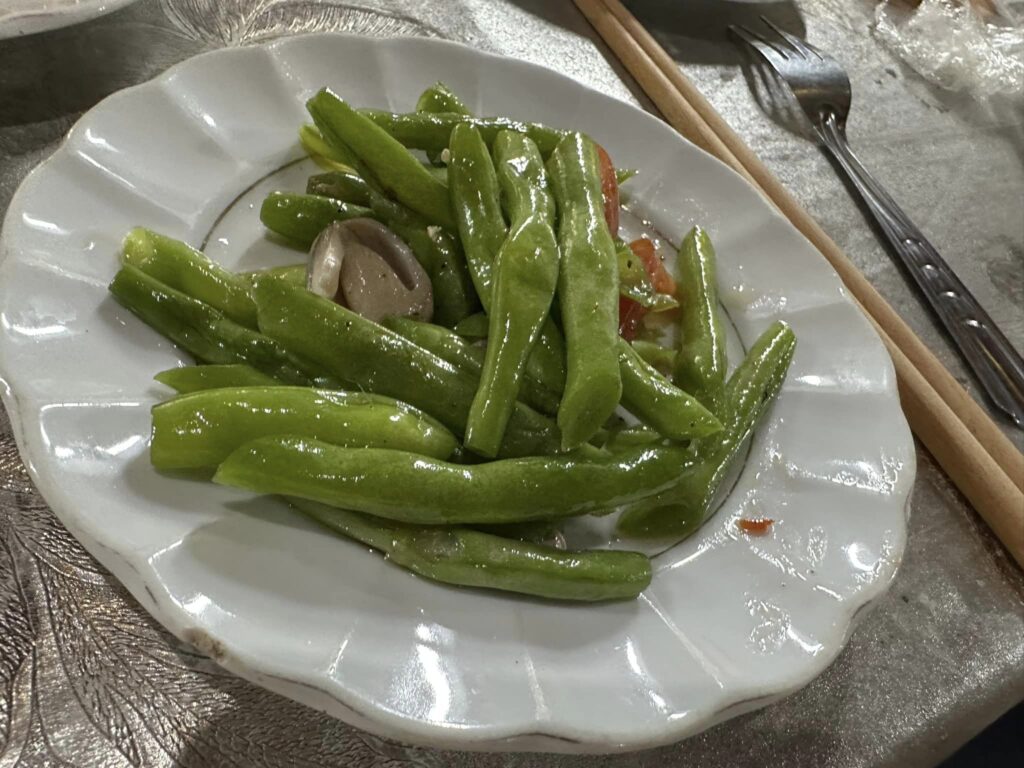
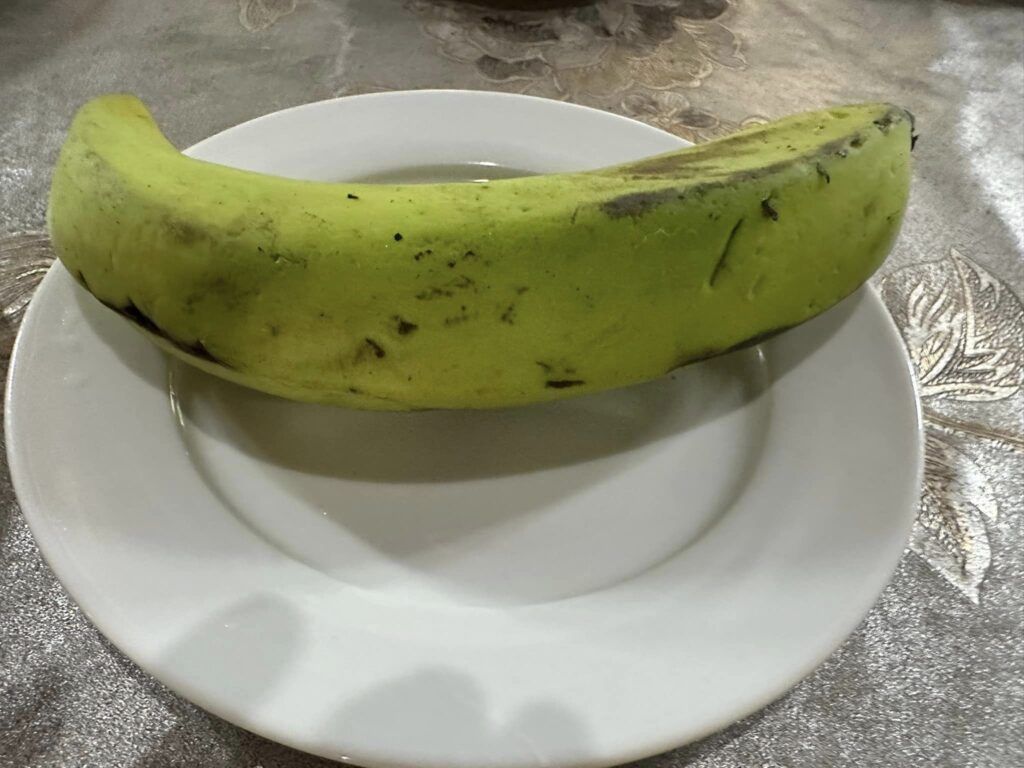
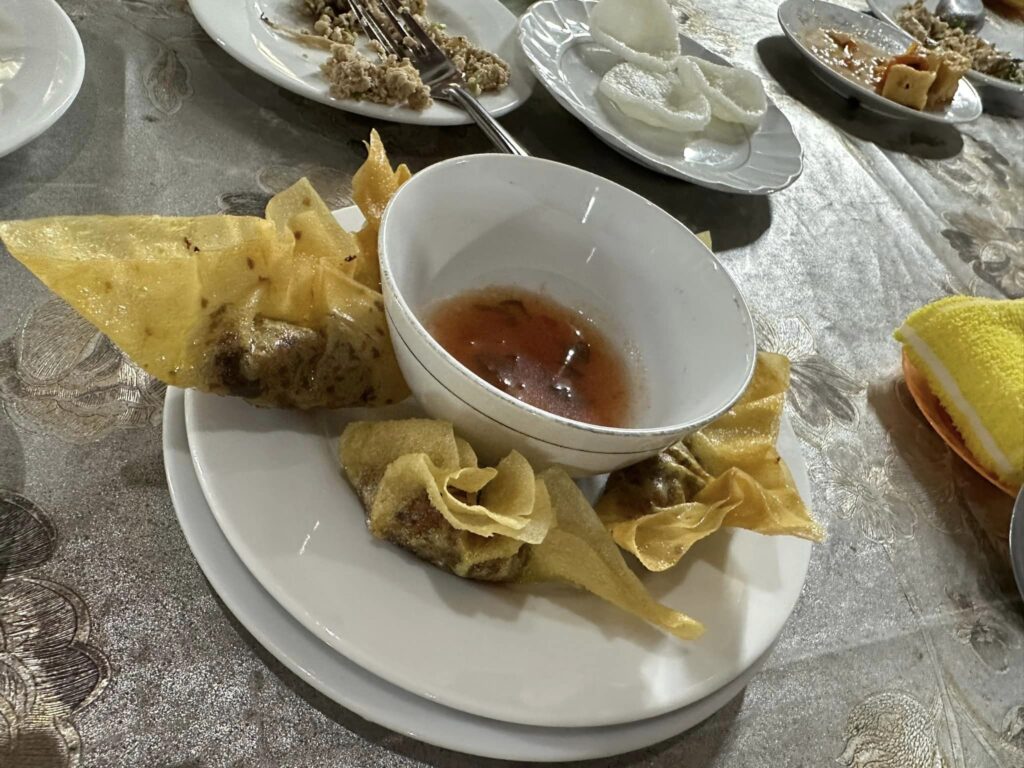
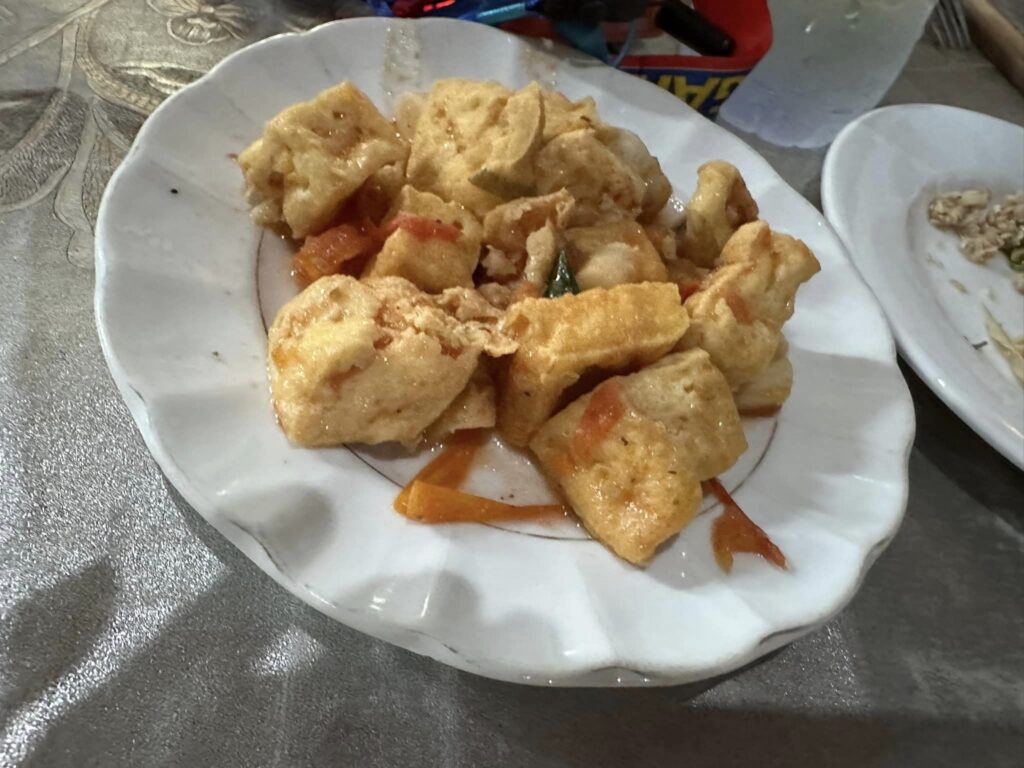
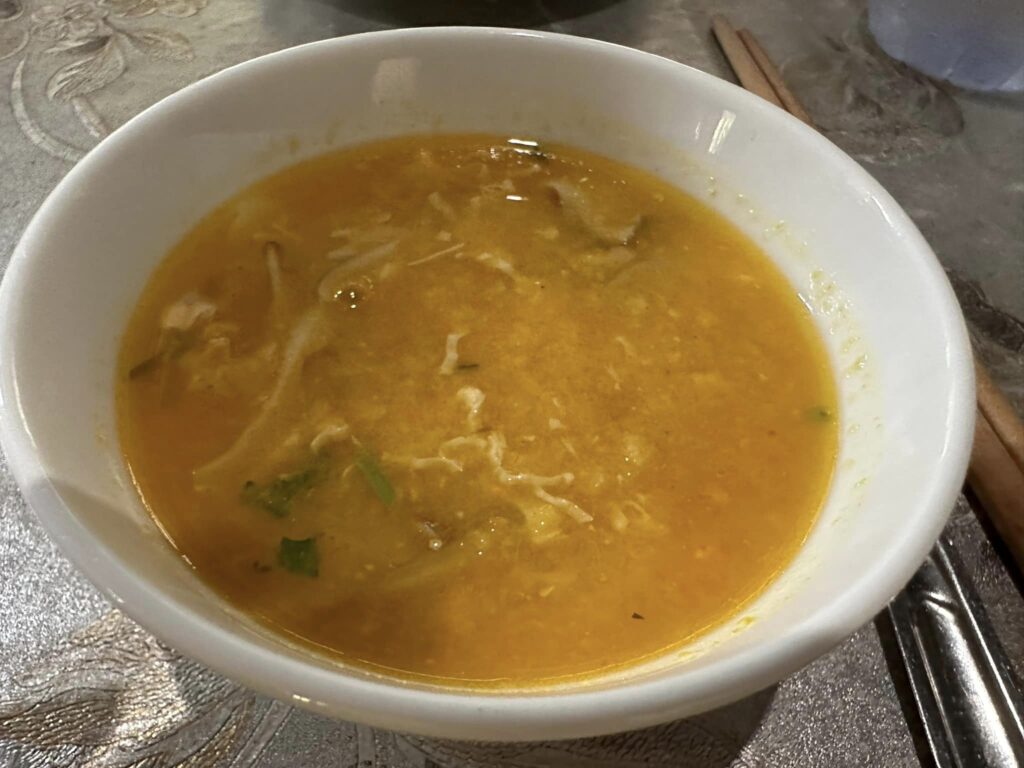
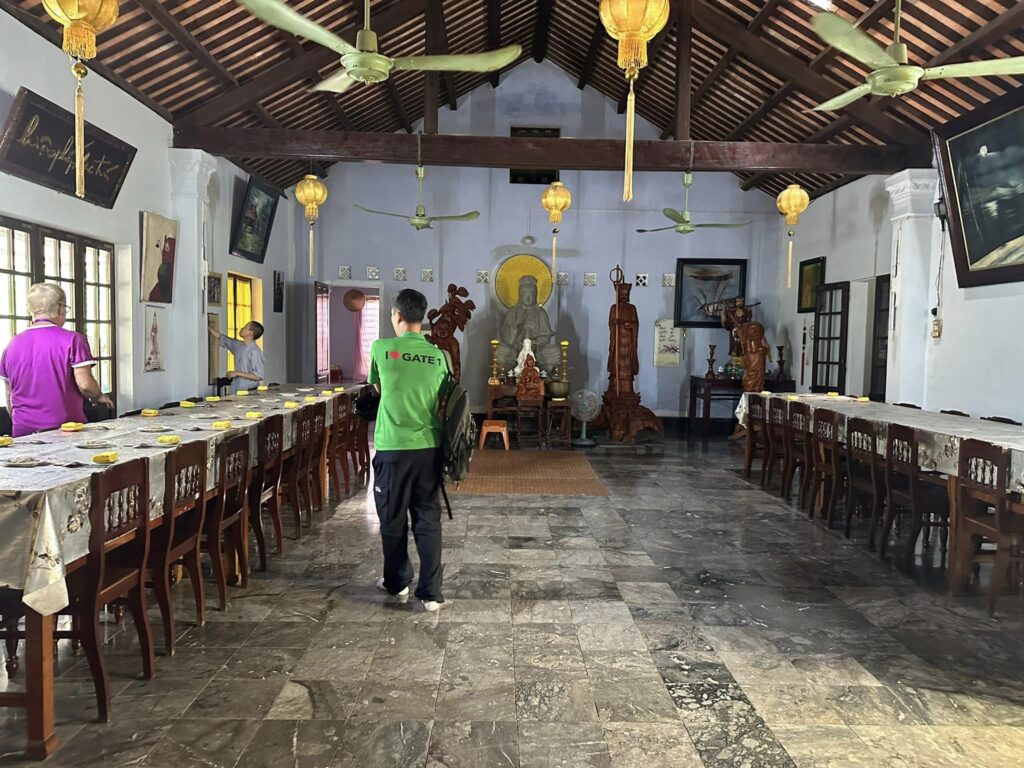
After lunch, we headed back to the bus and made a stop at our final sightseeing destination of the day. The Khai Dinh Tomb is the tomb of the most recent king (1920s), before Vietnam stopped having kings. We climbed up 127 steps to get to top. After entering gate, There are life-size stone statues of royal family, warriors, horses, and elephants. They were erected to emphasize the idea that it will help the king in his afterlife. The tomb and walls are ornately decorated with images of animals, flowers, and symbols in rich gold and silver. Bronze statues of the kings are located inside the palace.
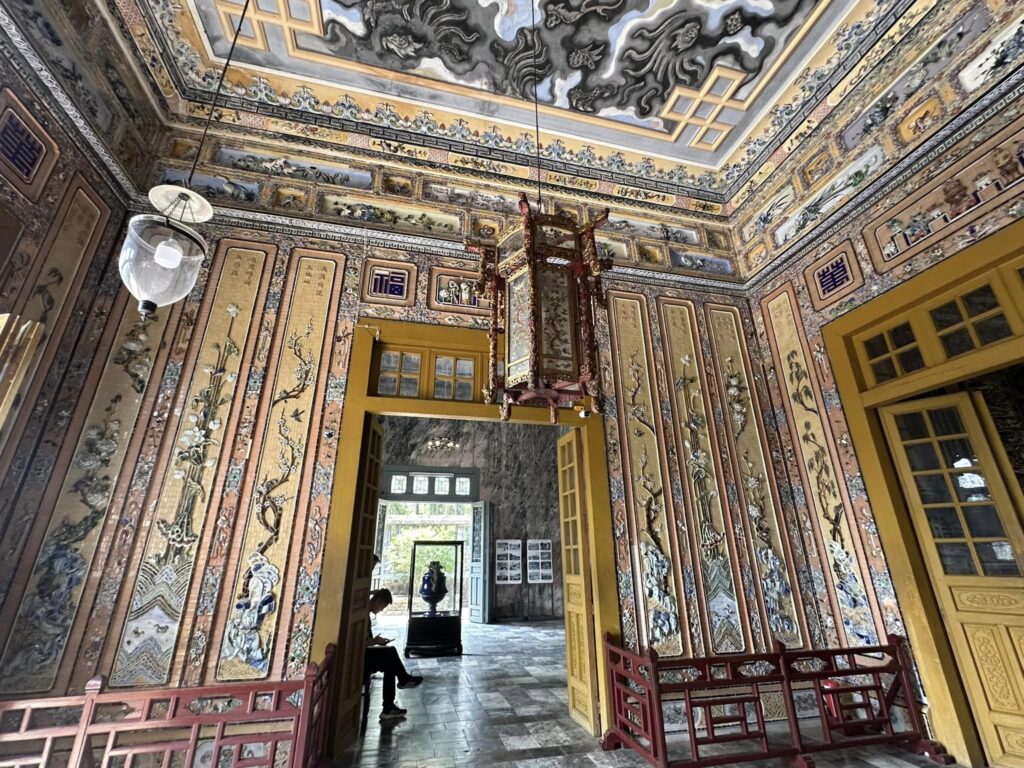
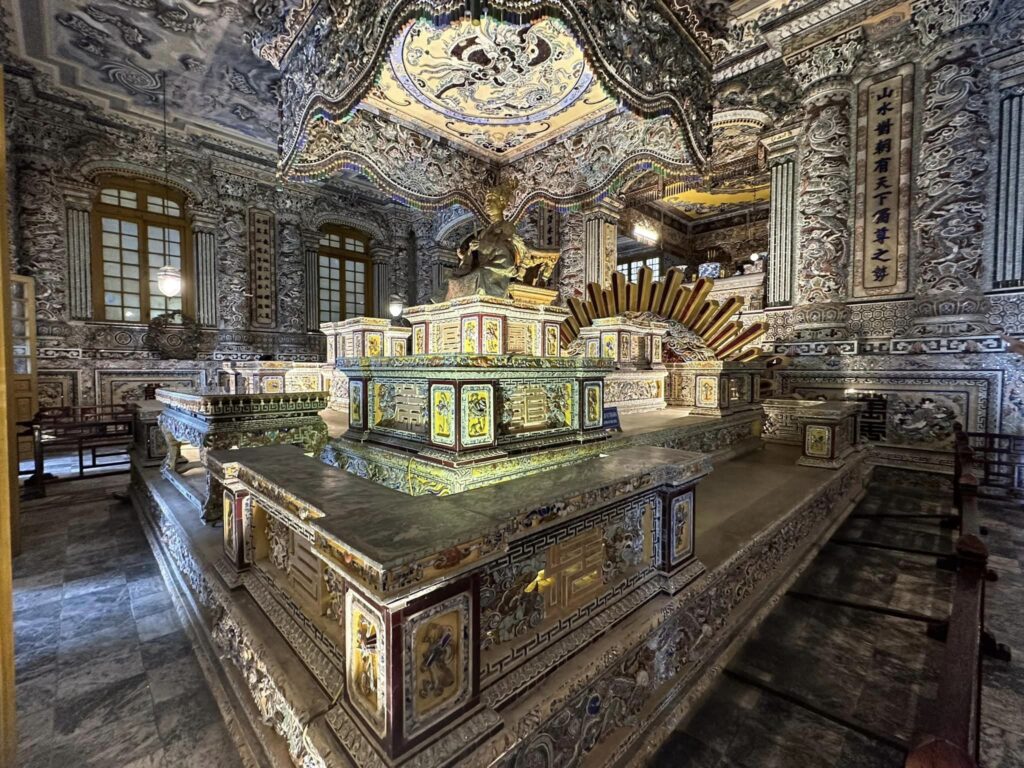
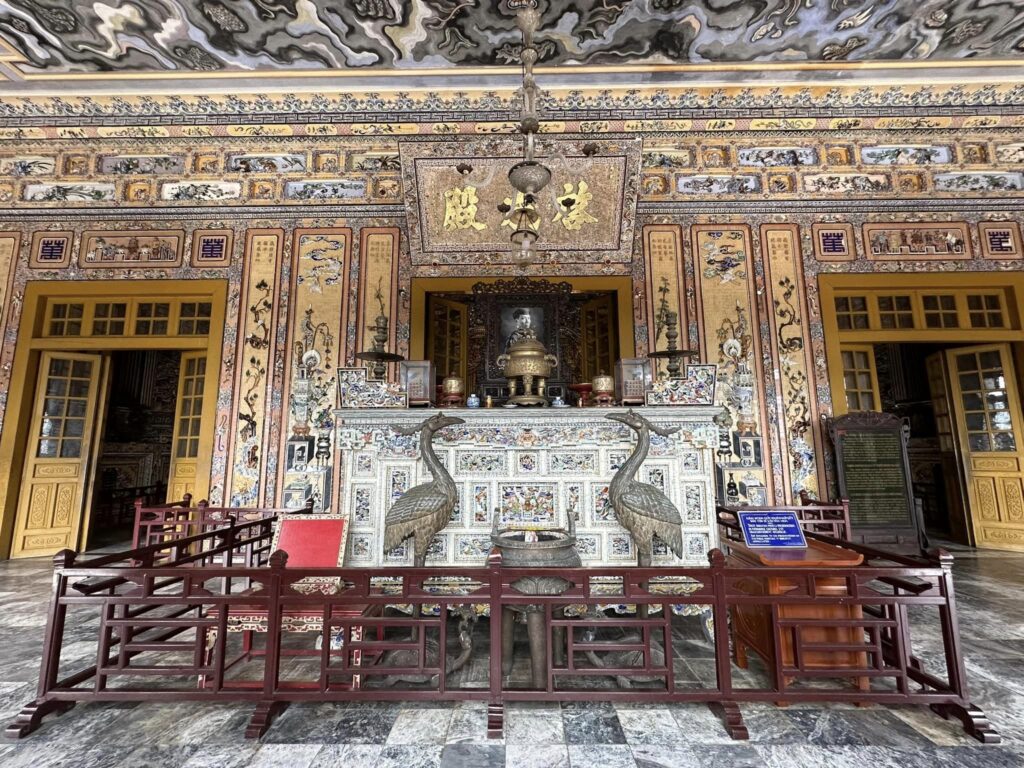
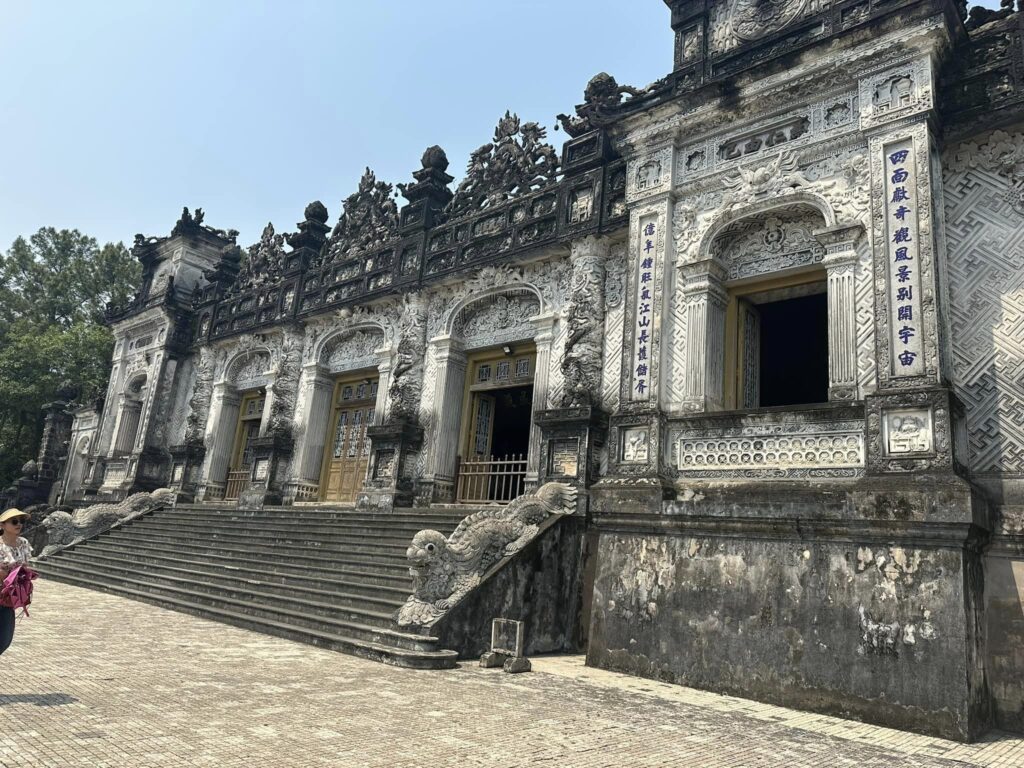
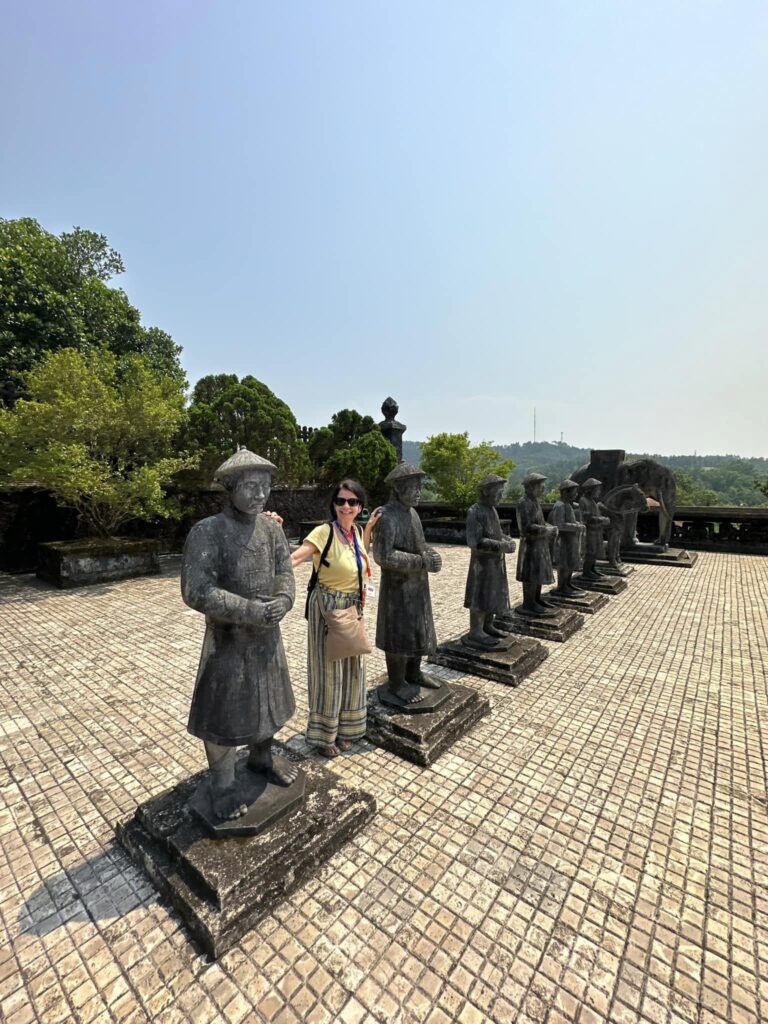
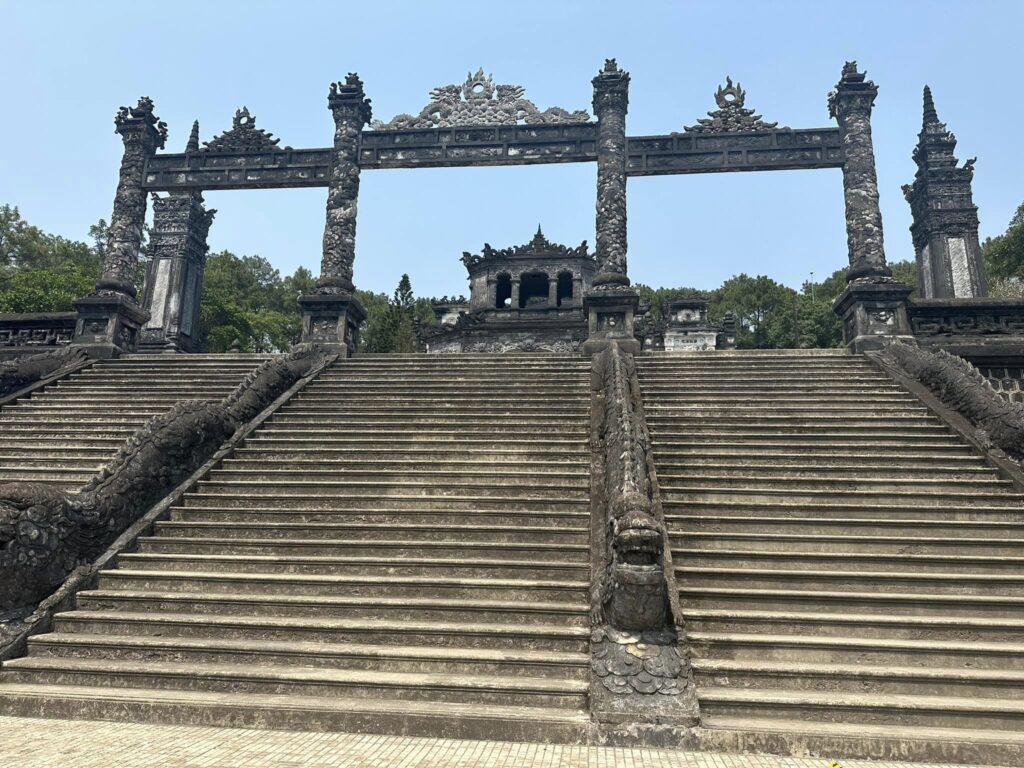
For dinner in Hue this evening, I dined at Quan Chay Lac Tam vegan restaurant. My meal selection was the vermicelli noodles with fried tofu and faux meat, mushroom and veggie soup, seaweed, green tea, and a dessert che soup with coconut and ginger in sesame seed broth. Everything was delicious!!
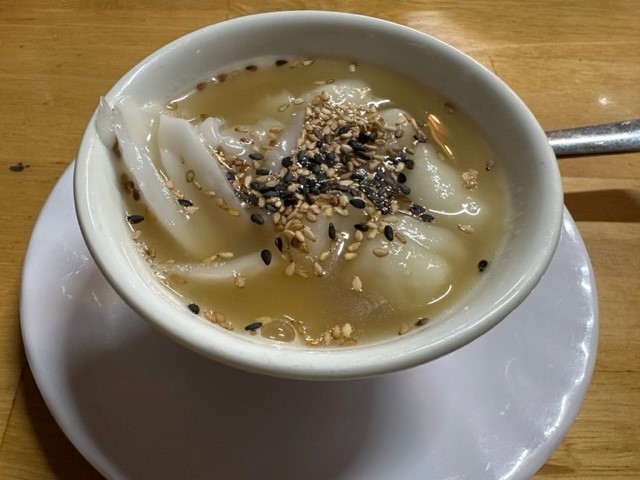
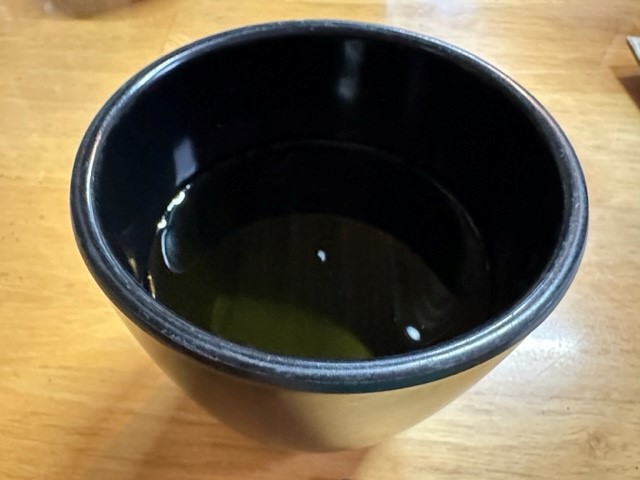
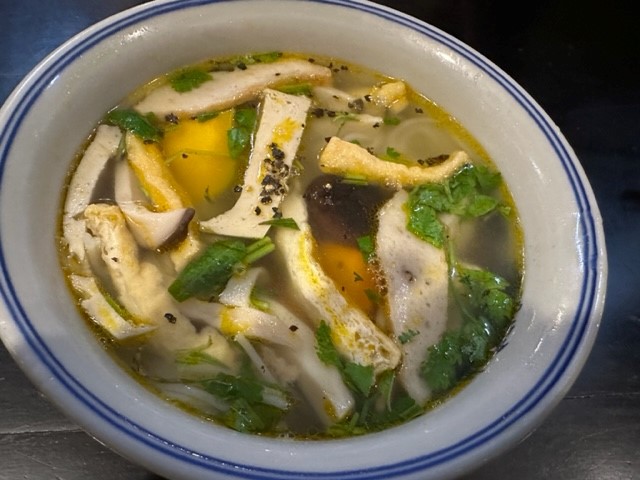
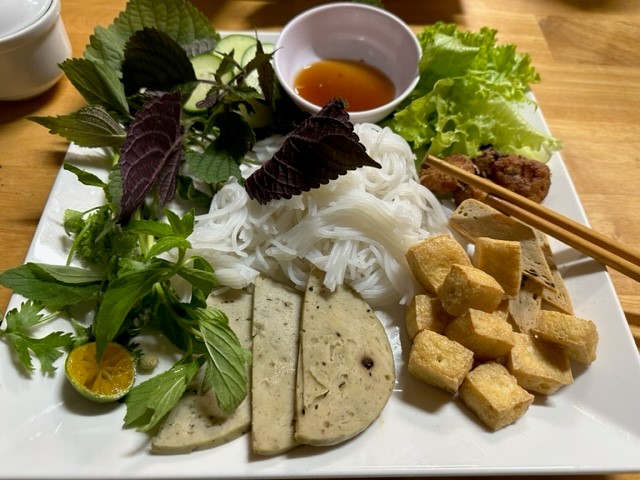
On our last morning in Hue, my tour group had breakfast at our hotel’s restaurant. I chose the passionfruit, dragonfruit, pineapple, bread, mango, and purple congee soup for my morning meal.
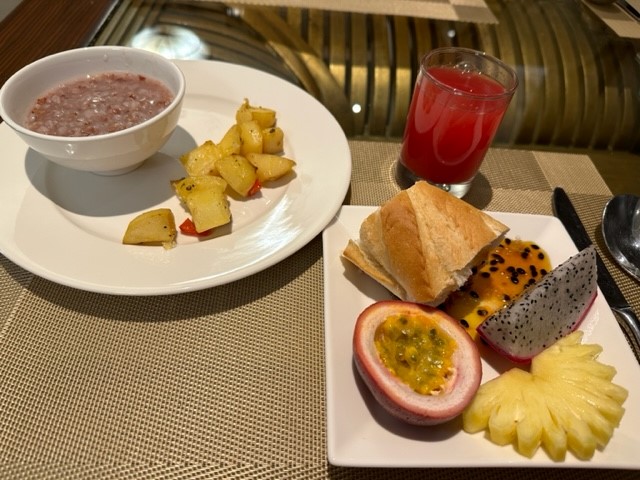
We then headed to the airport in Hue, for our flight to Hanoi.
At the Hue airport, I found a food vendor for my early lunch meal of a Vietnamese bao bun and a hot chocolate.
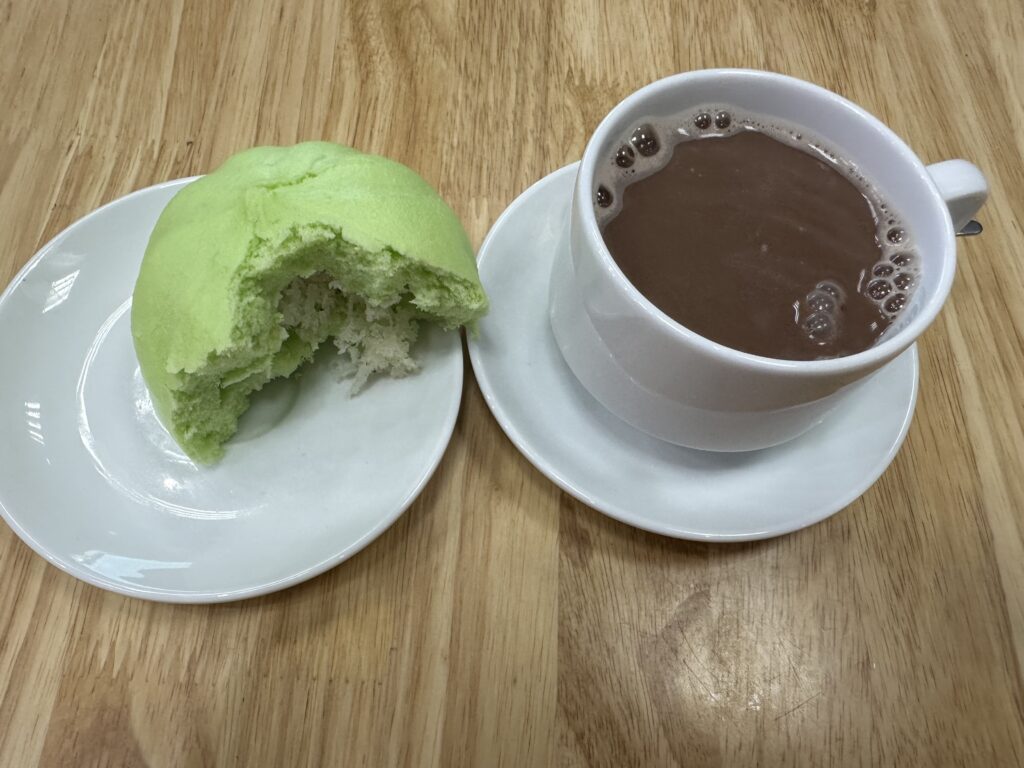
I really enjoyed my vacation time in the central Vietnam cities of ancient Hoi An and Hue, with their culture, historic architecture, and delicious foods. The next leg of my journey would be a visit to Ha Long Bay and Hanoi in the northern part of the country!!